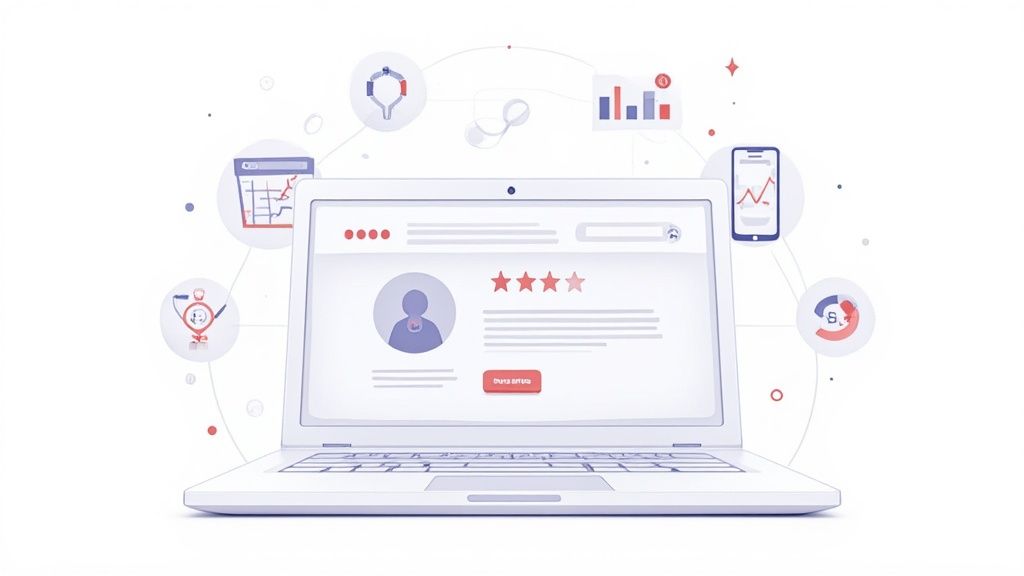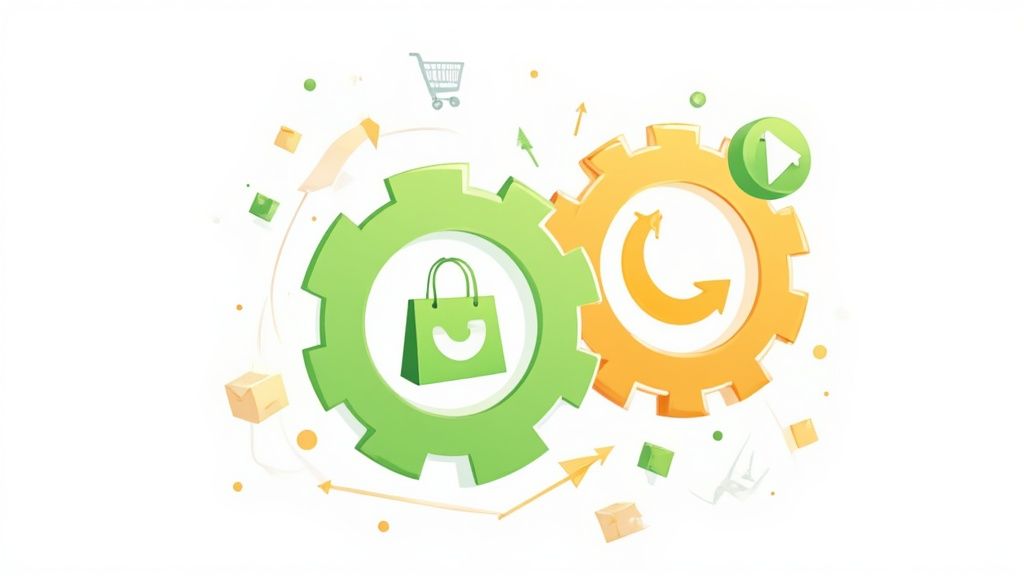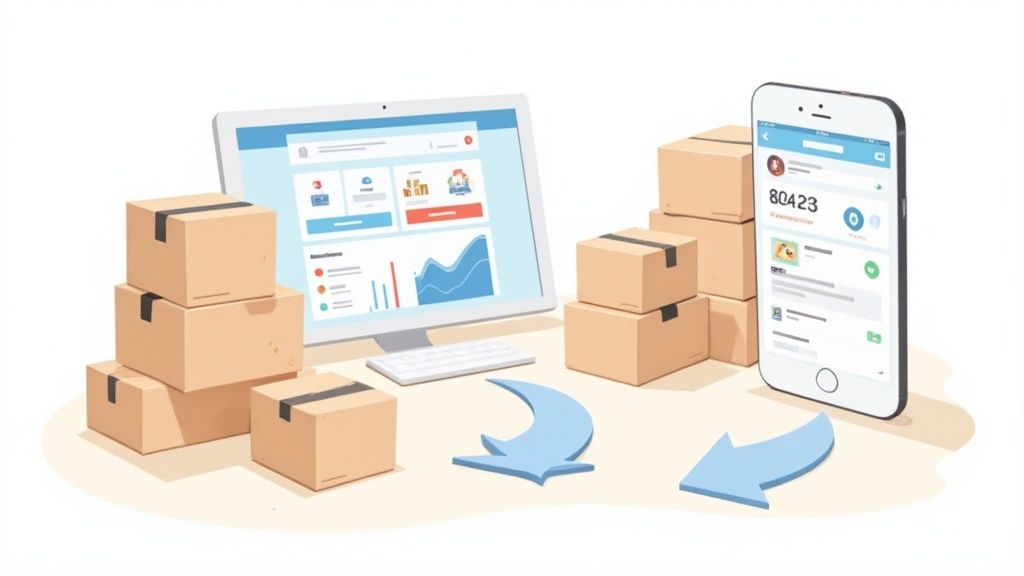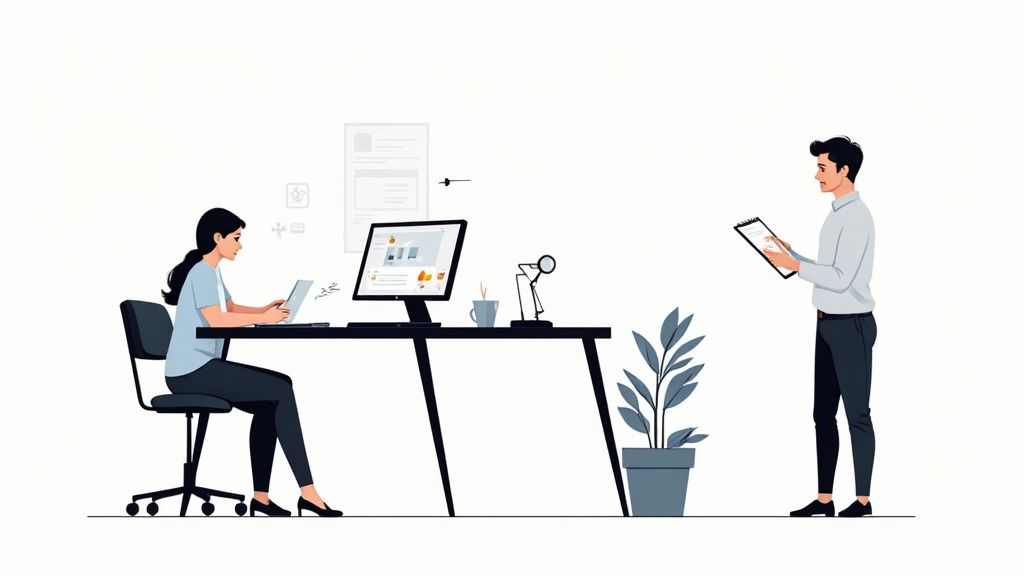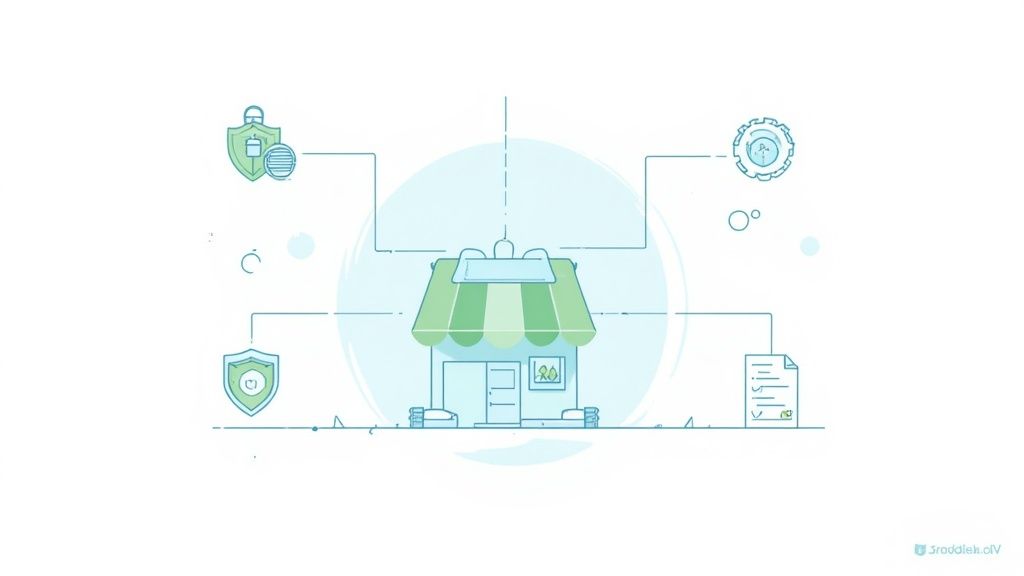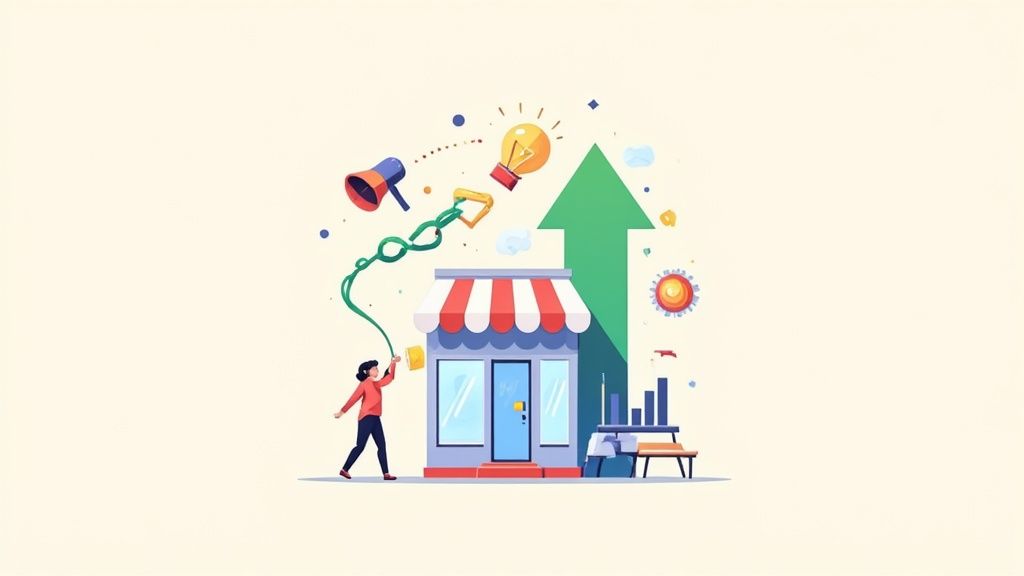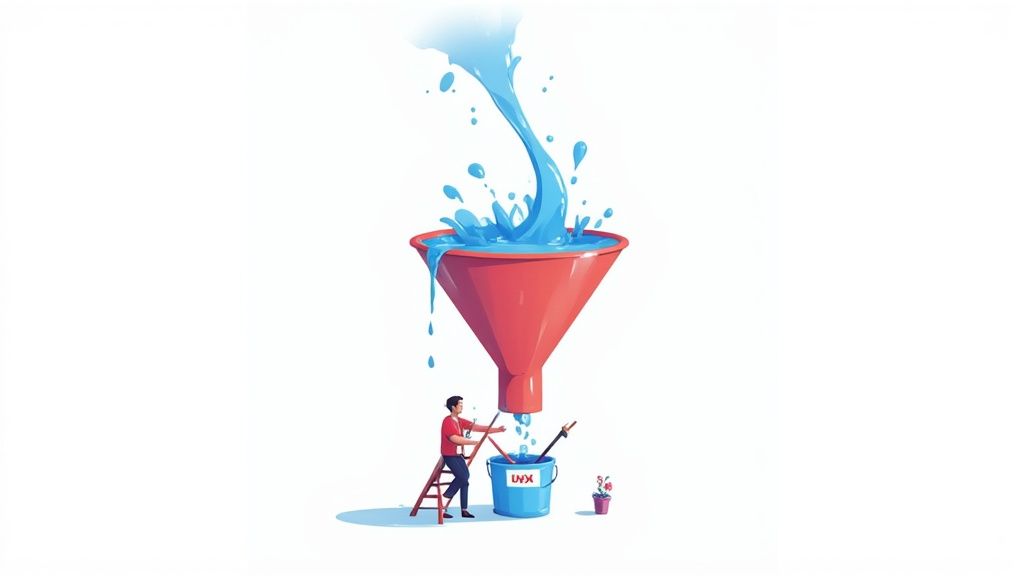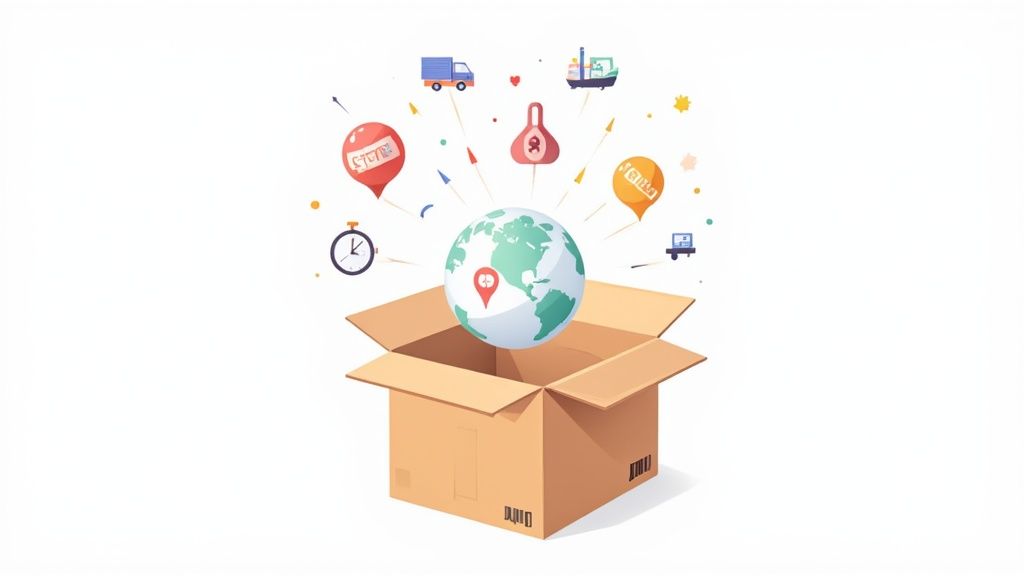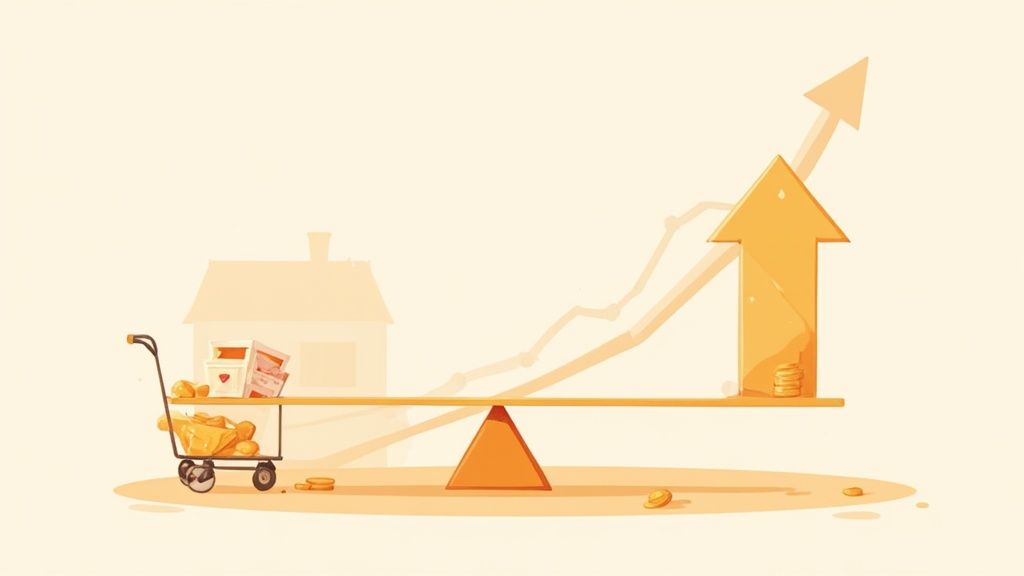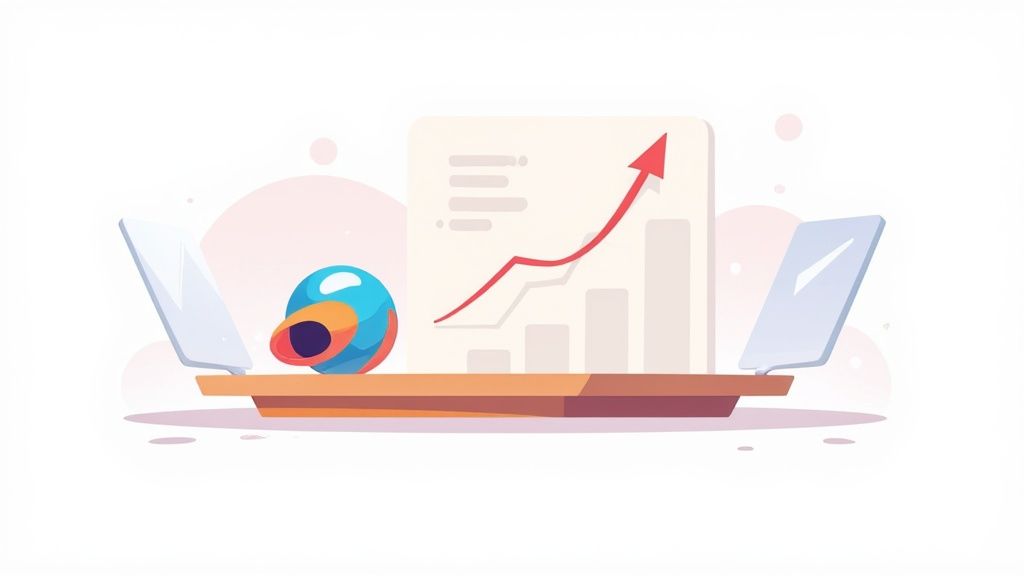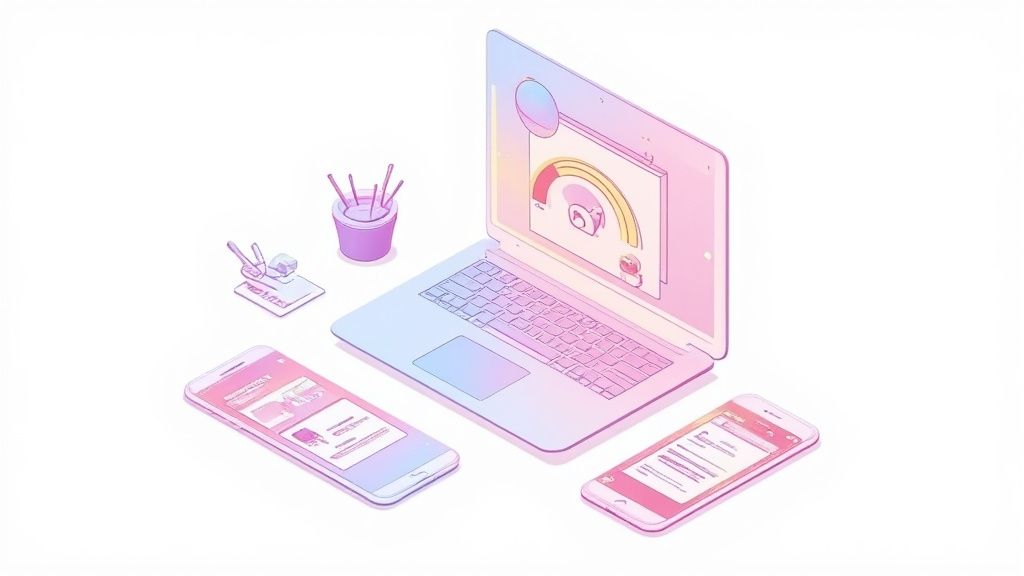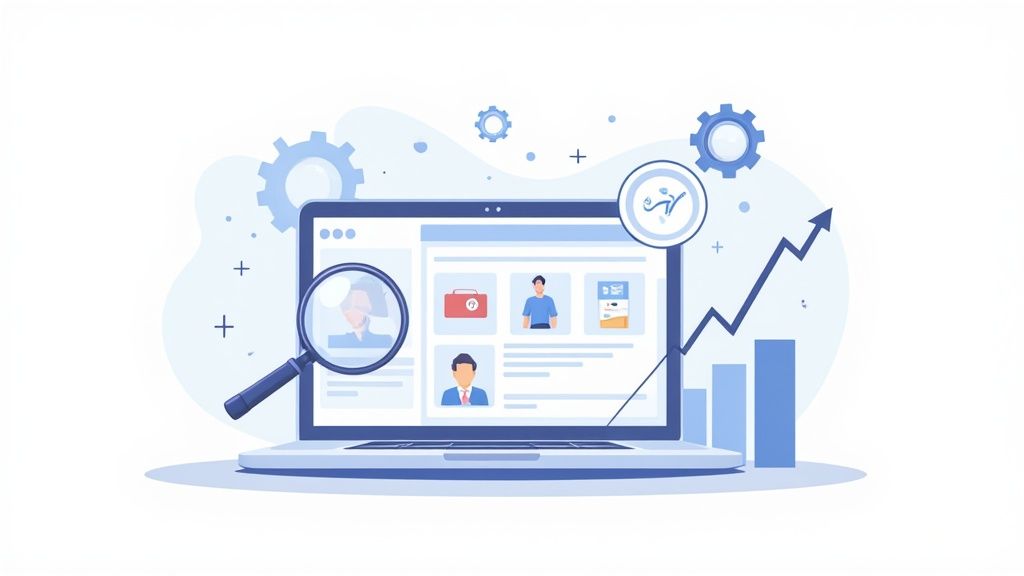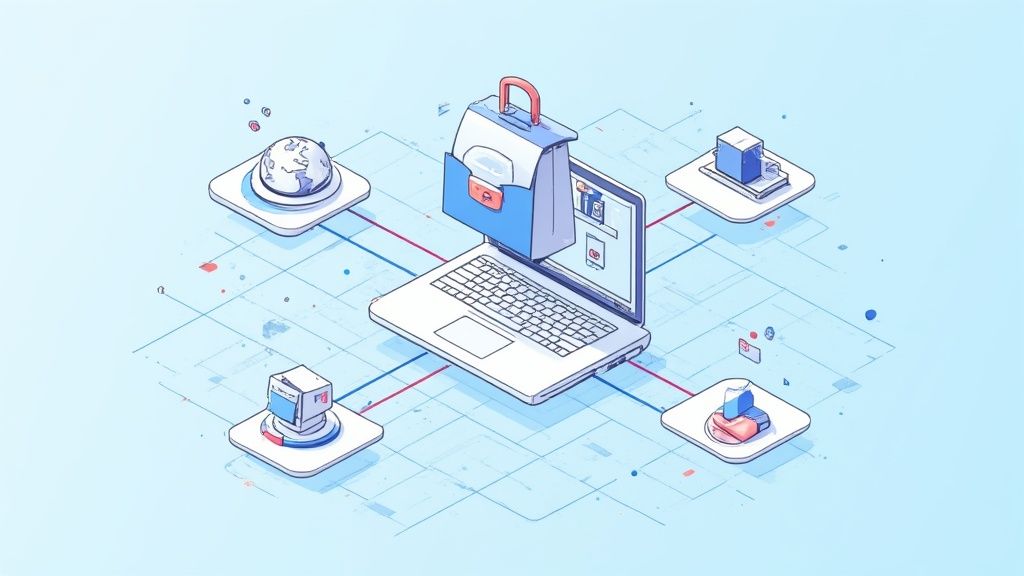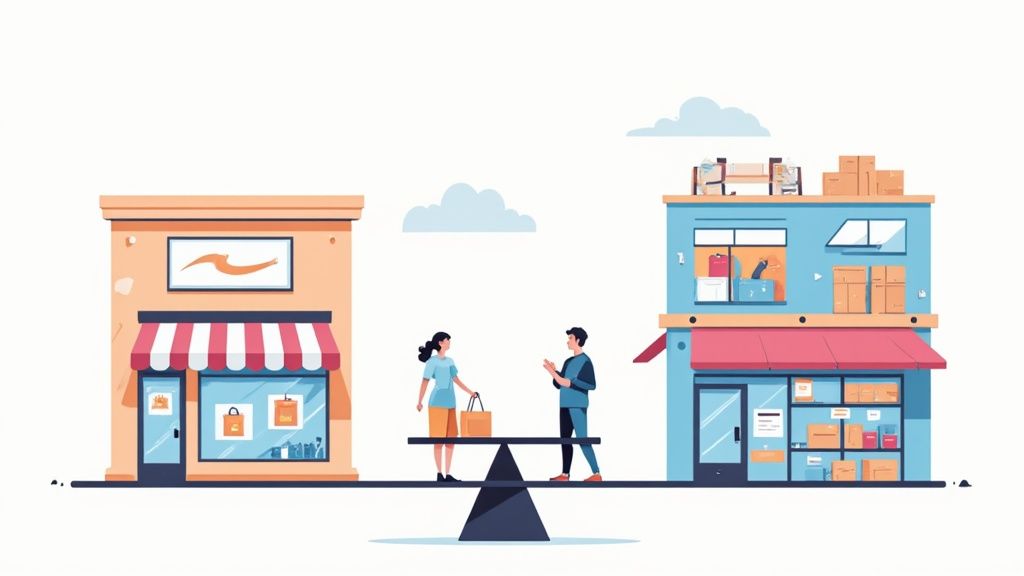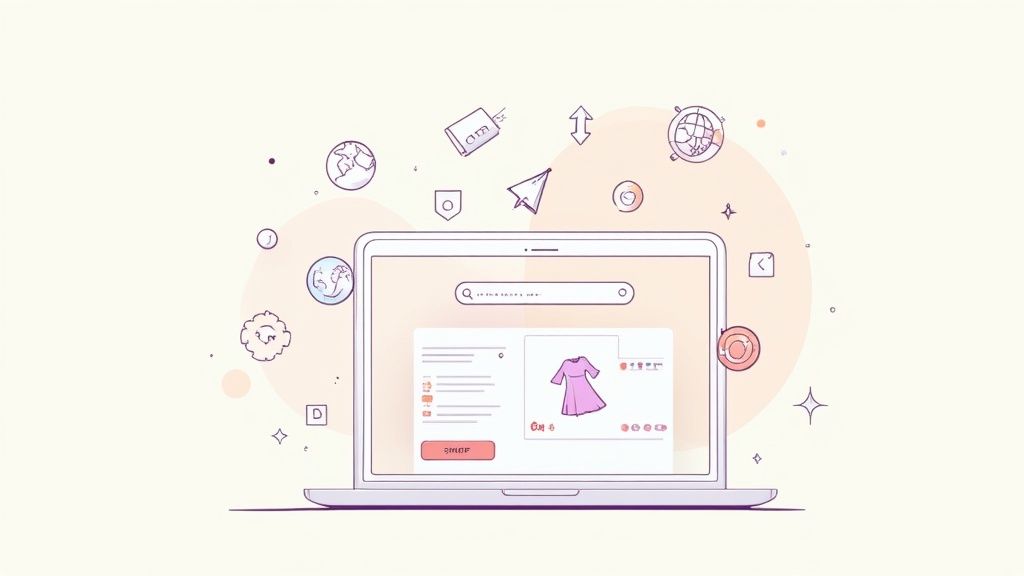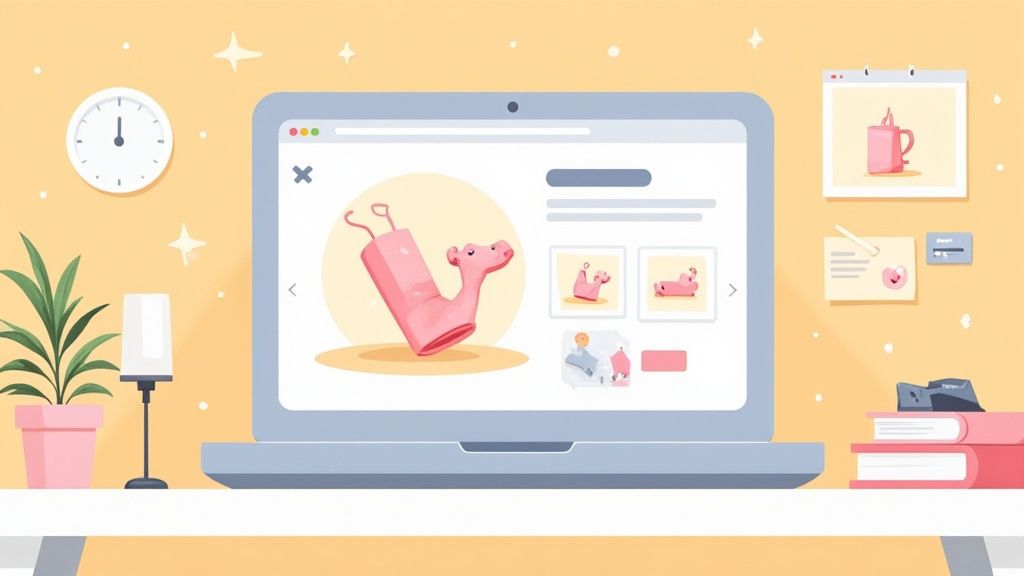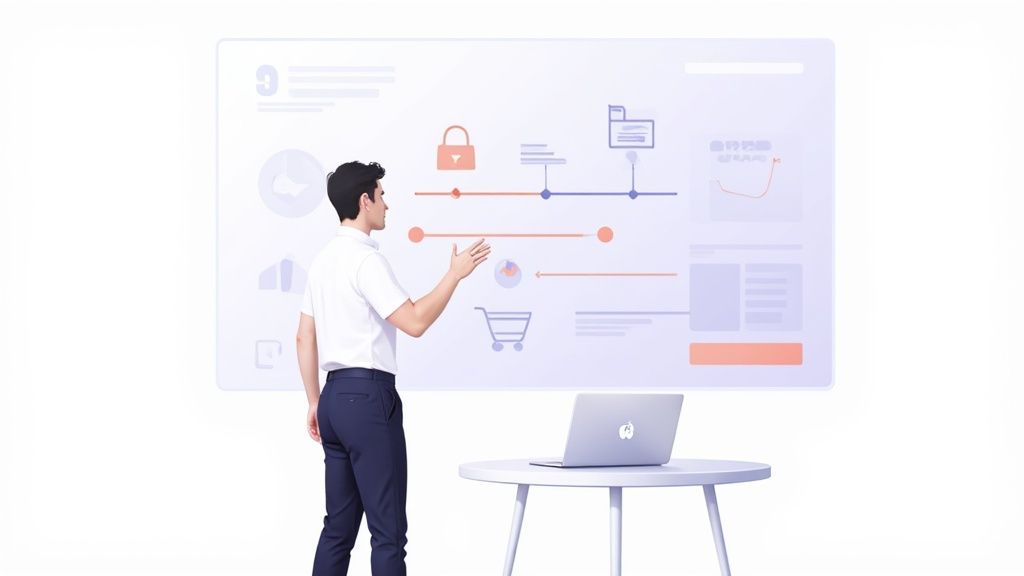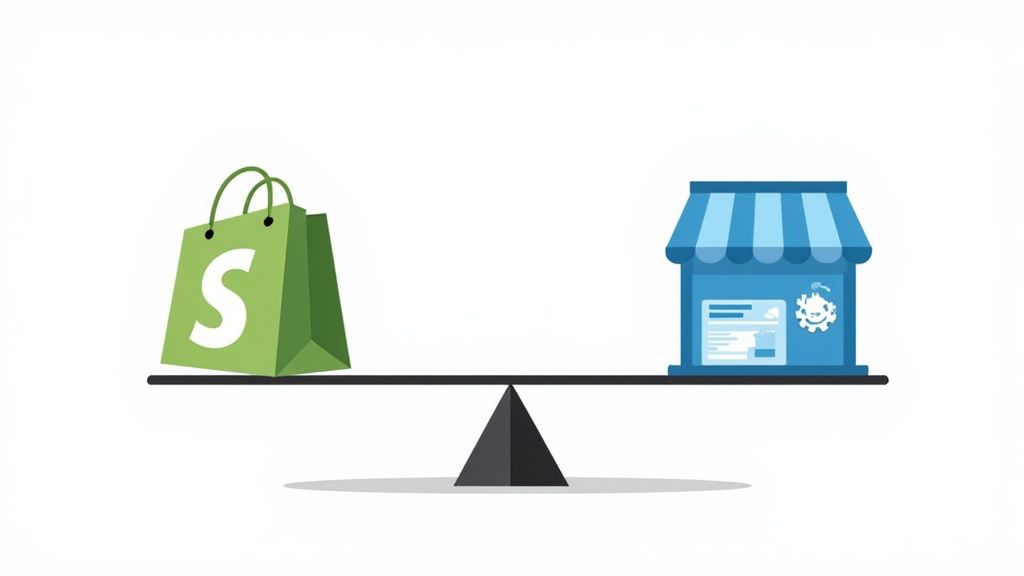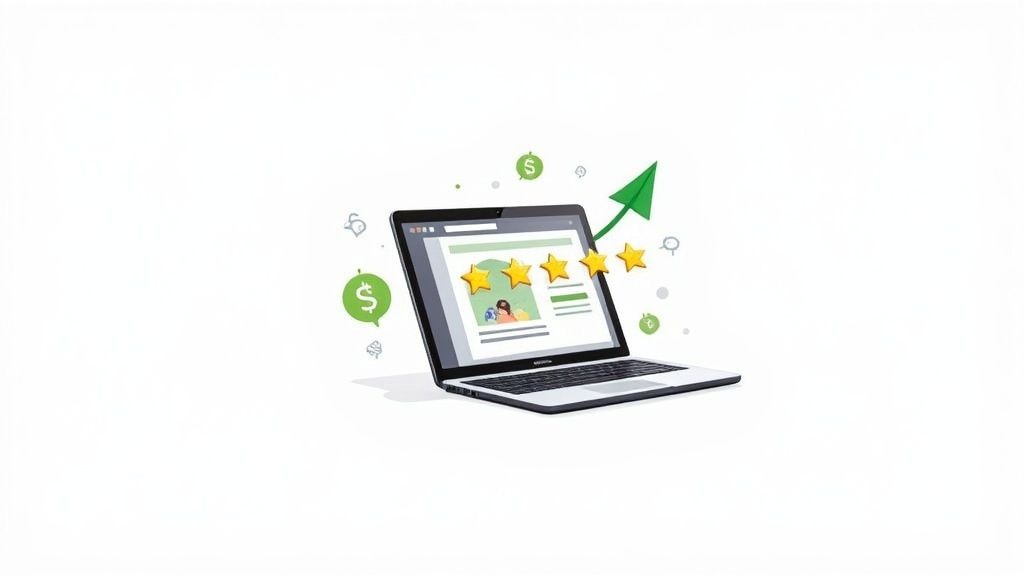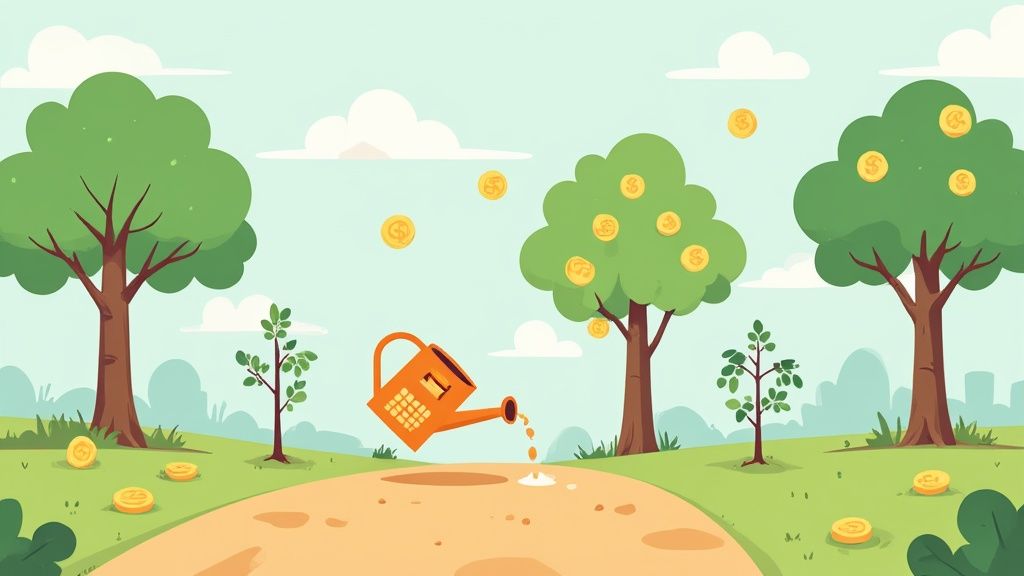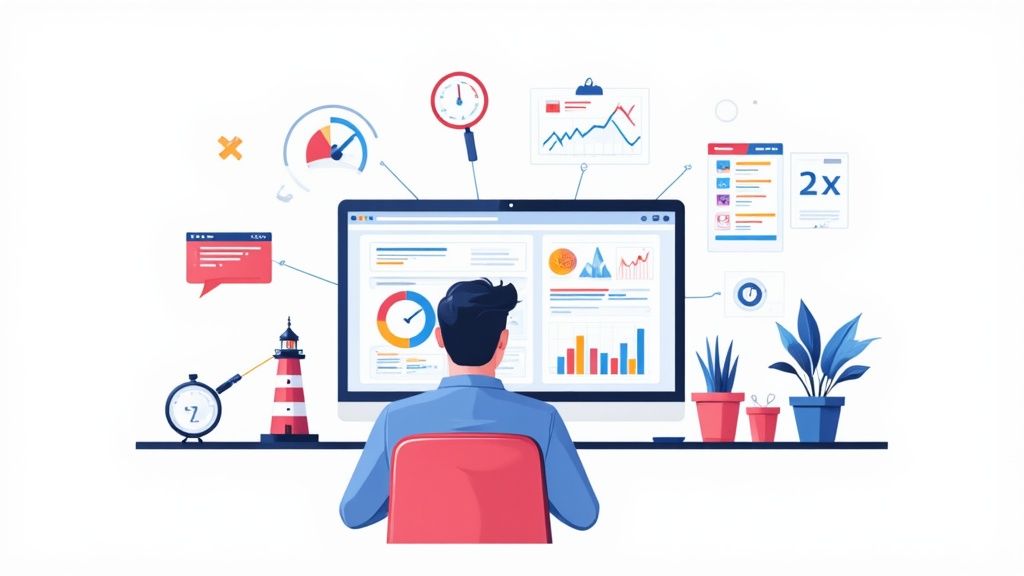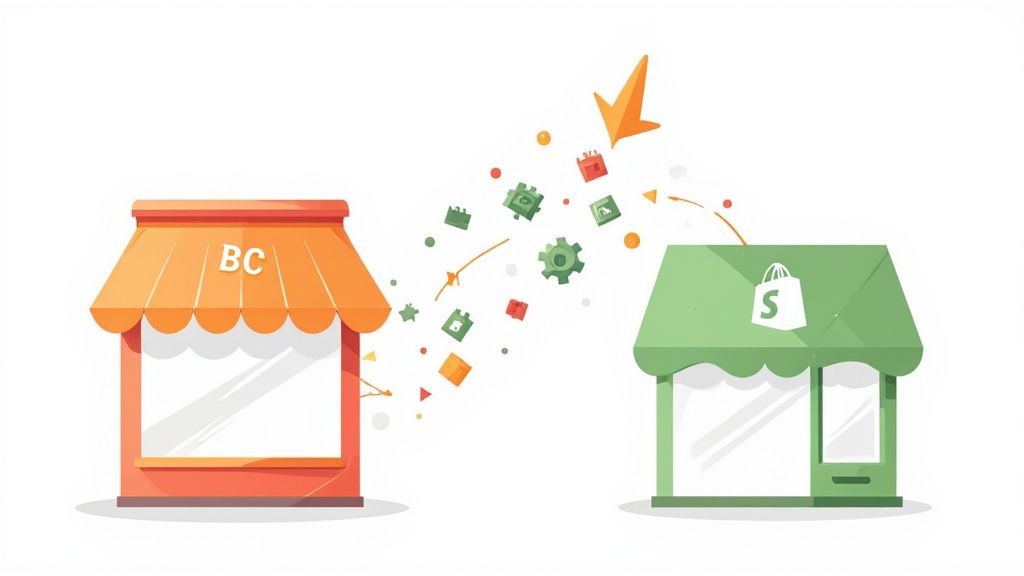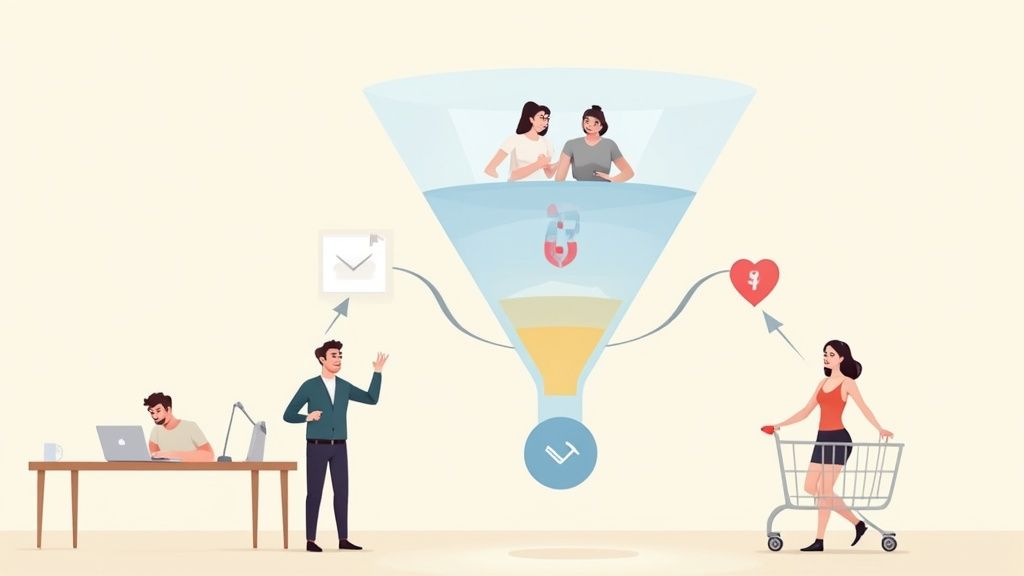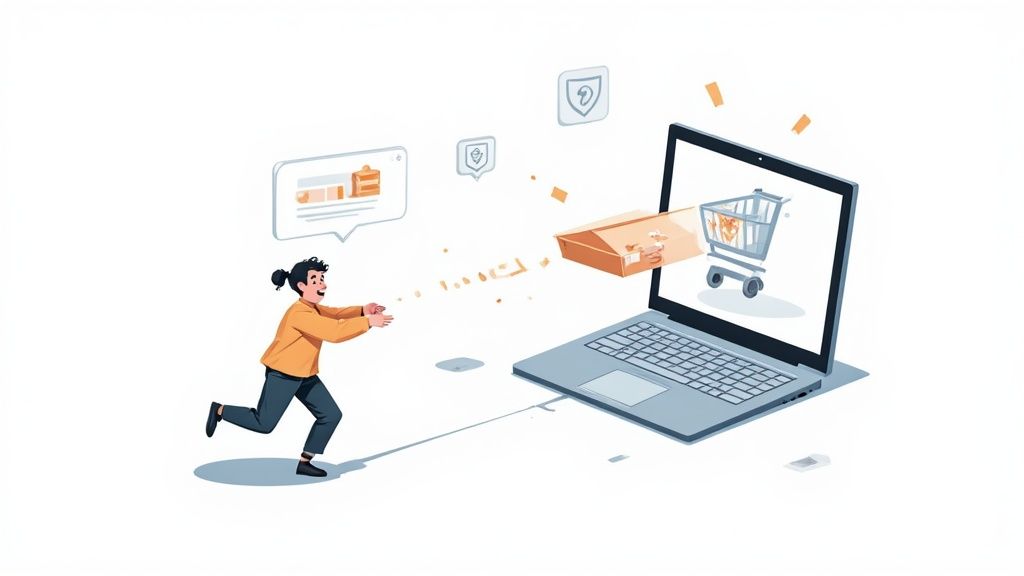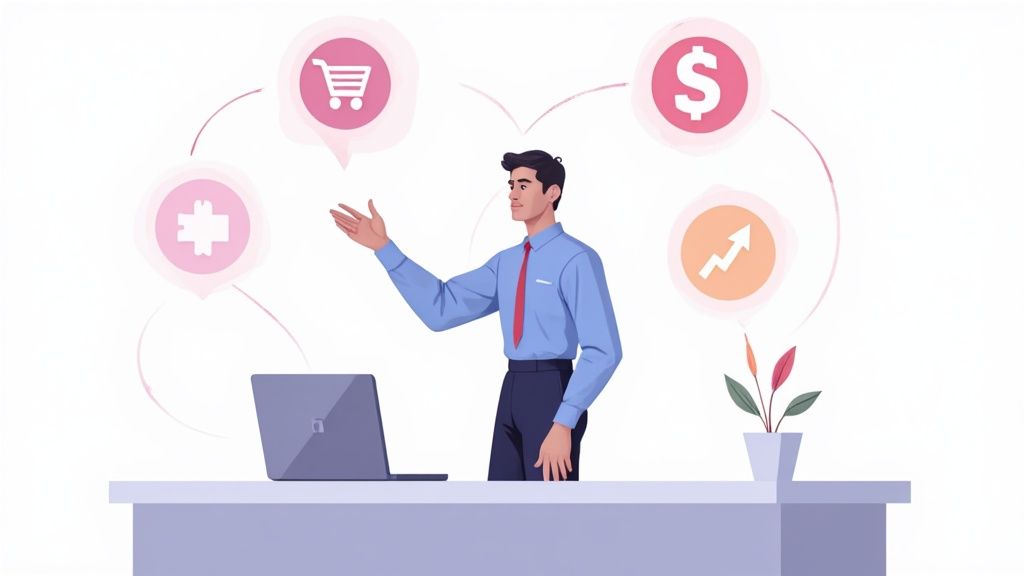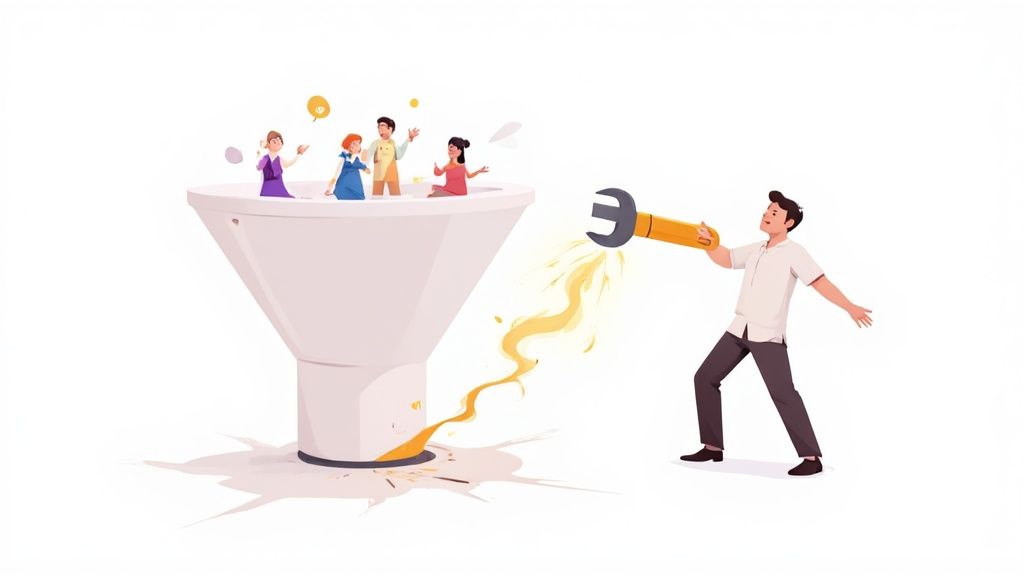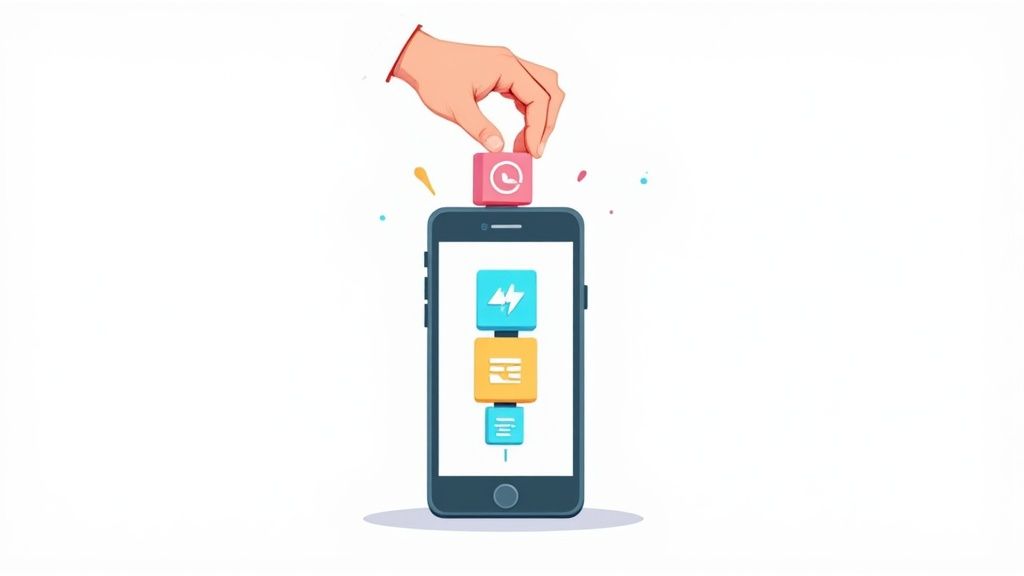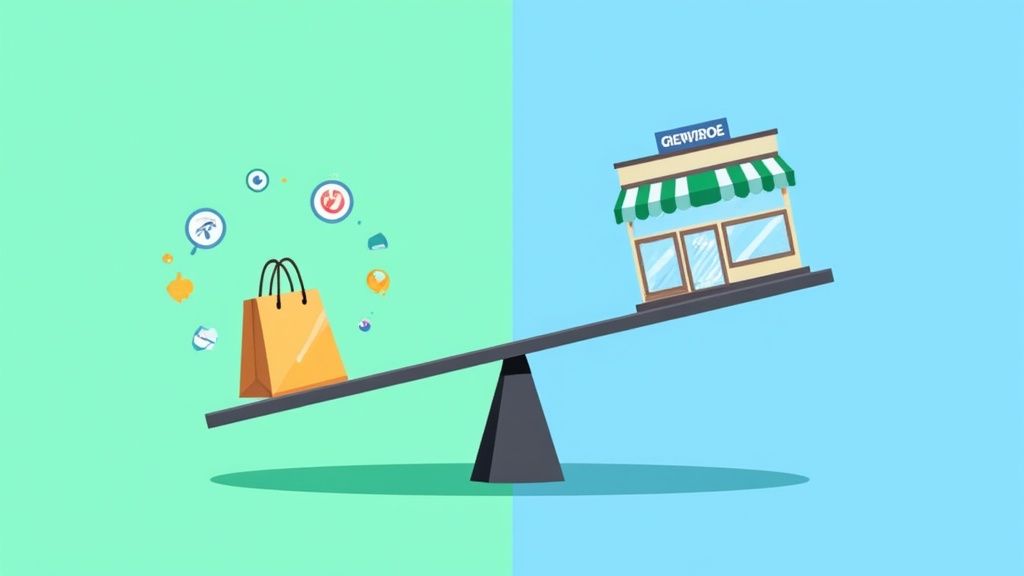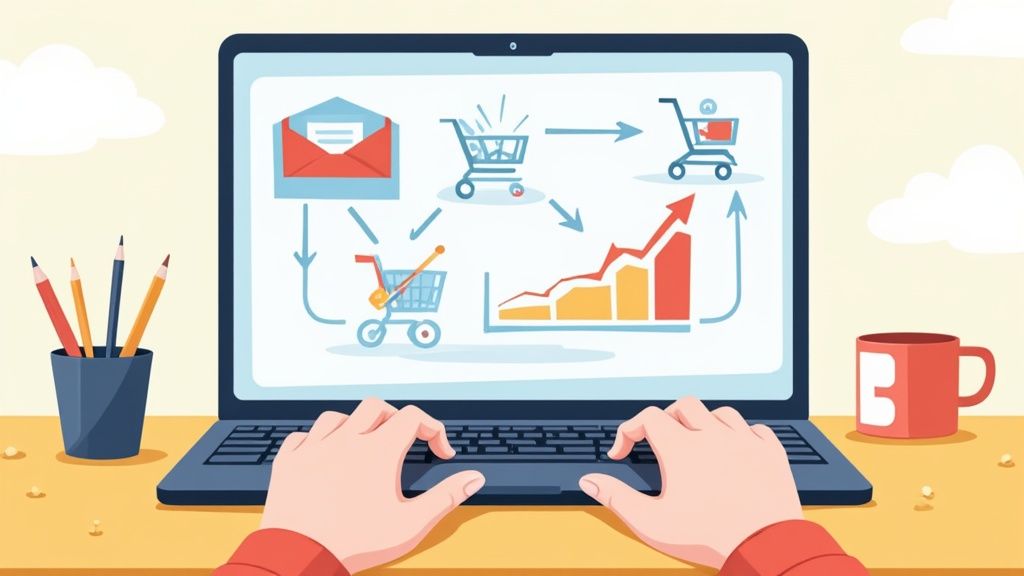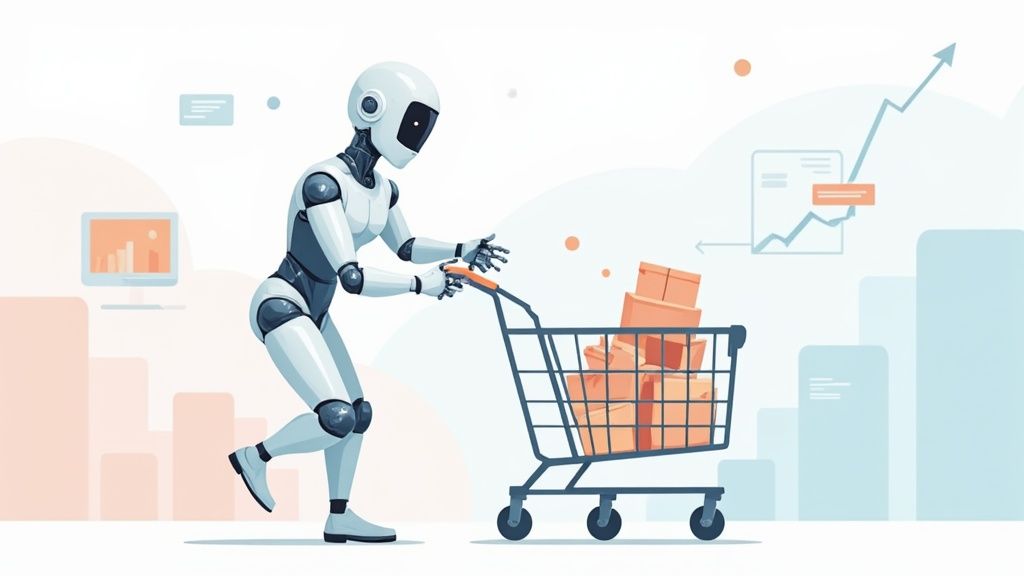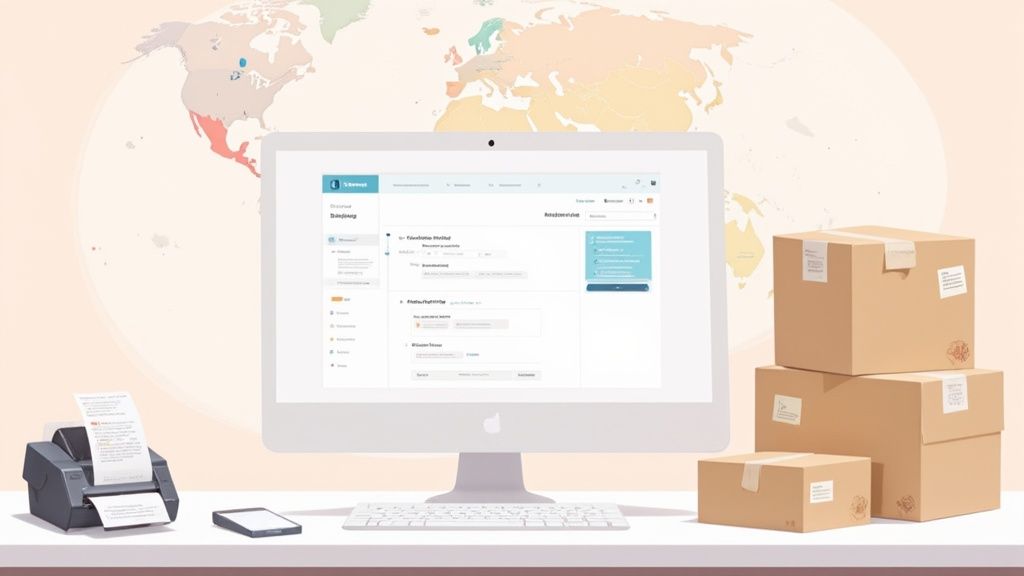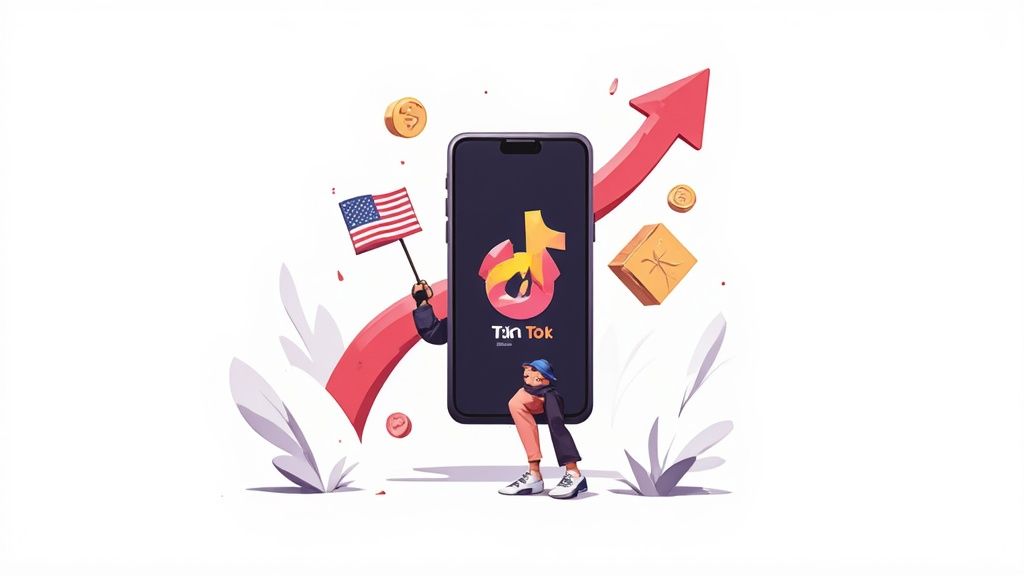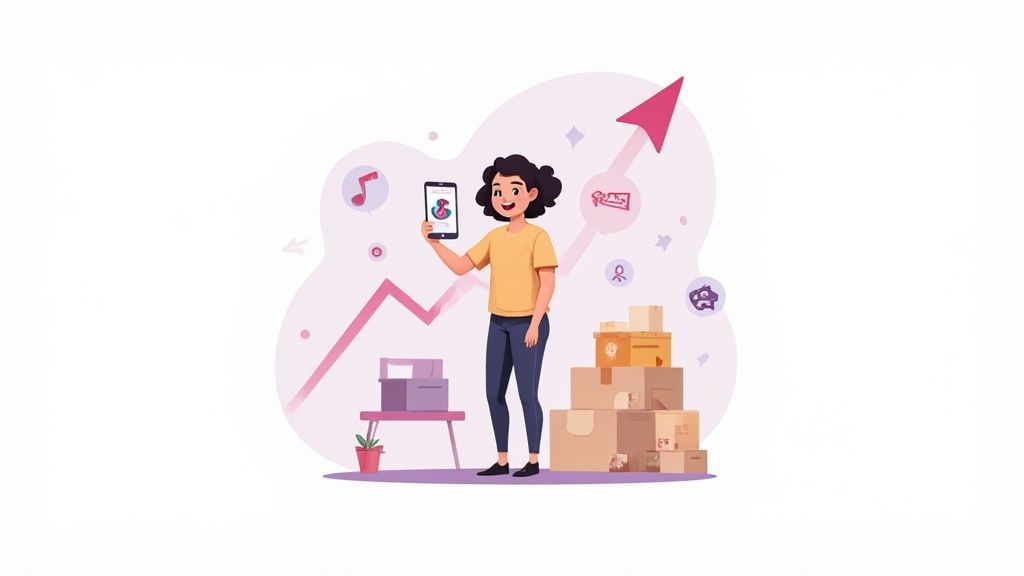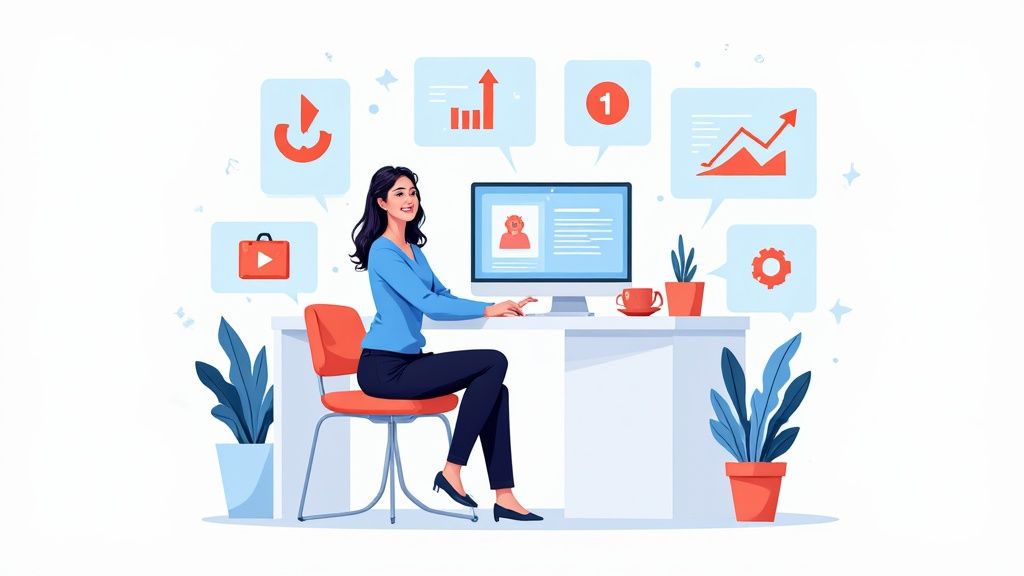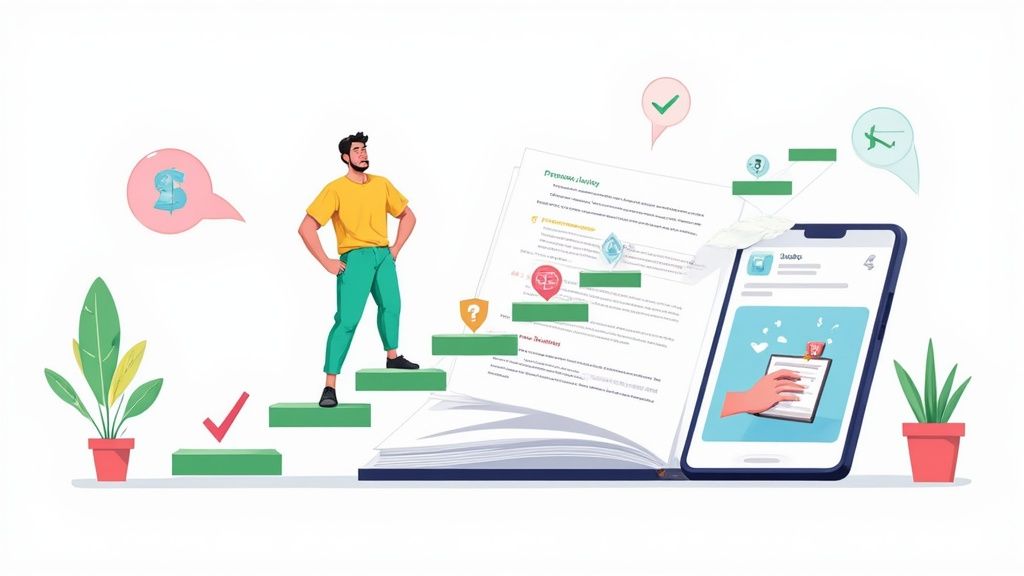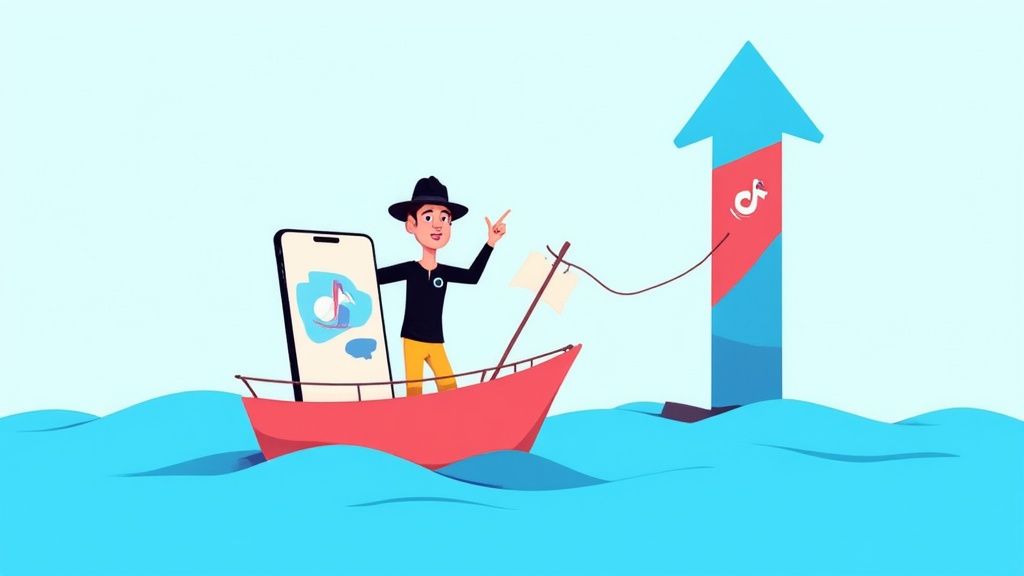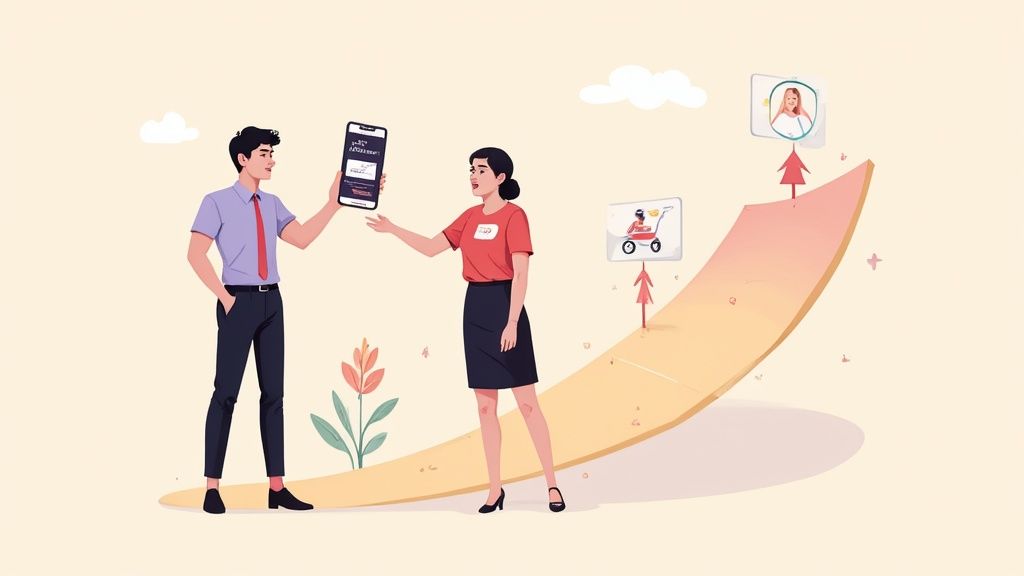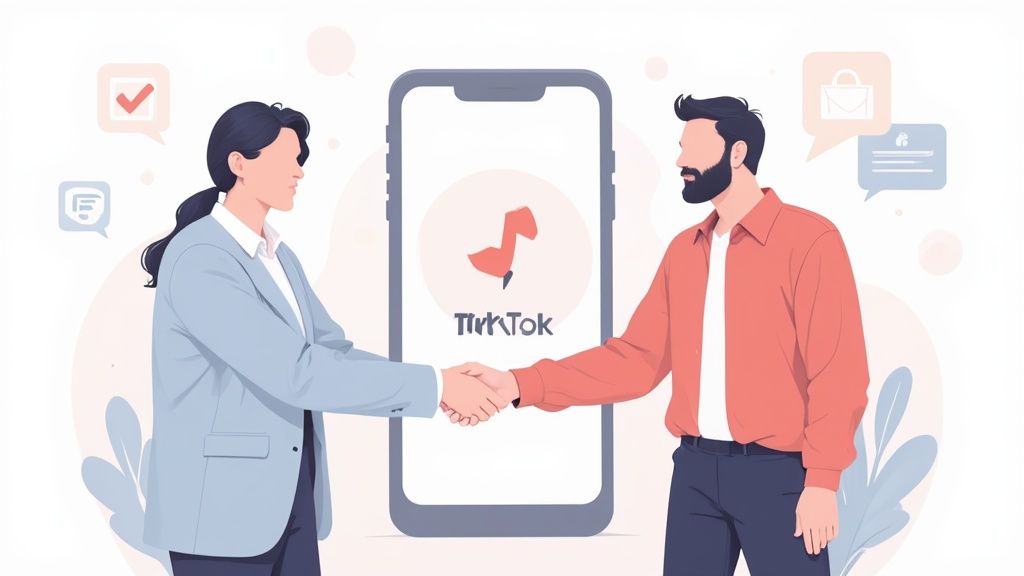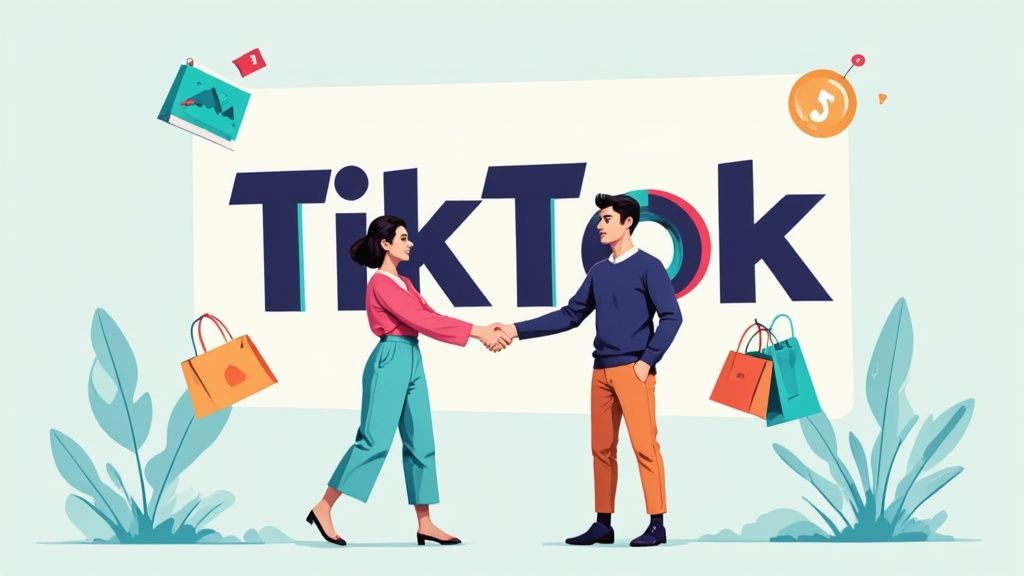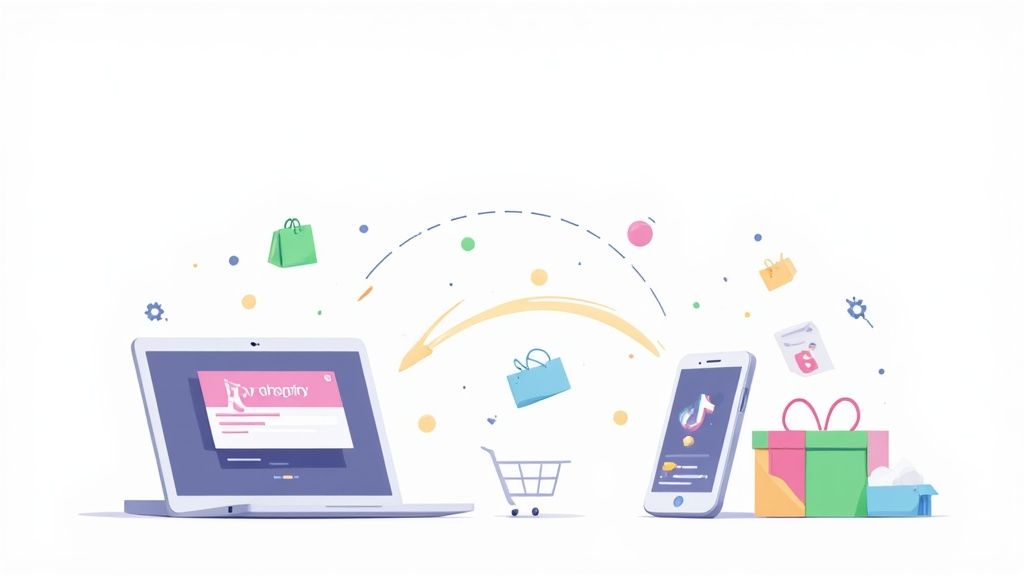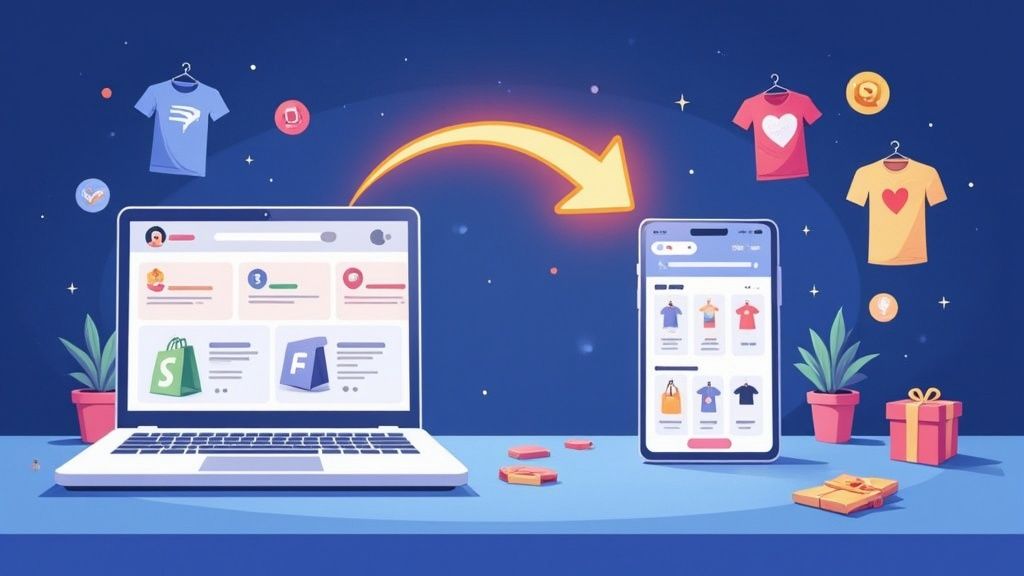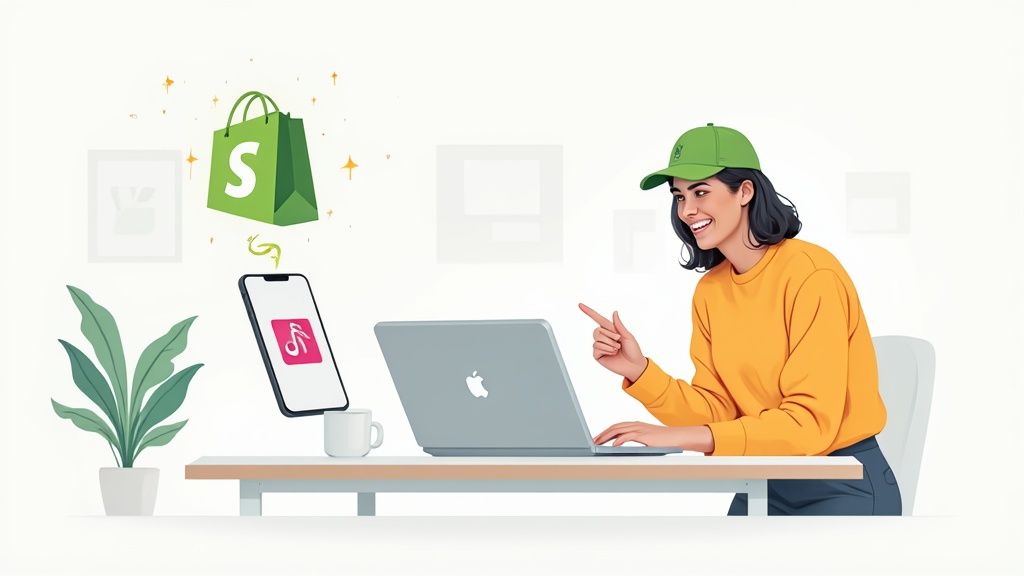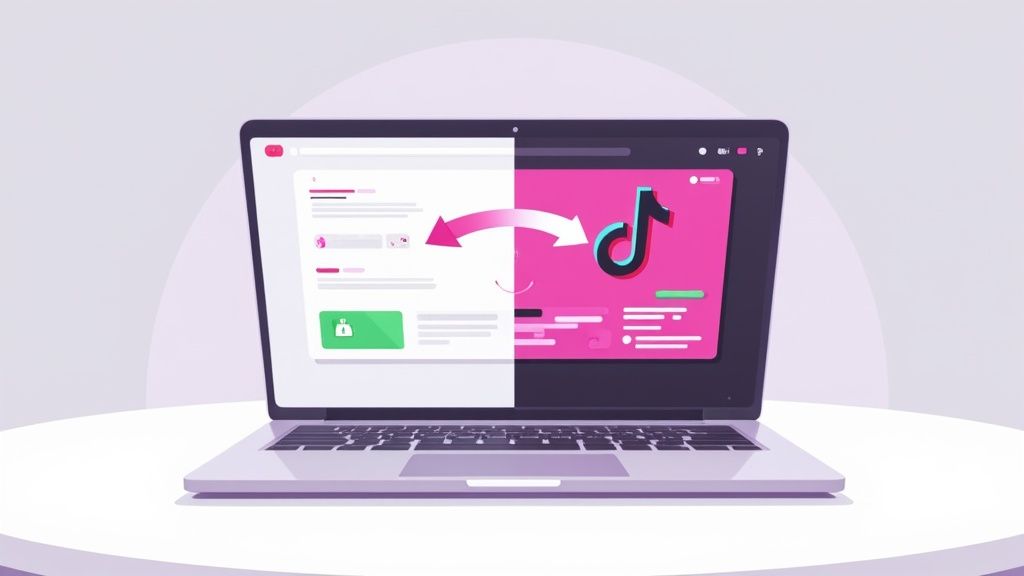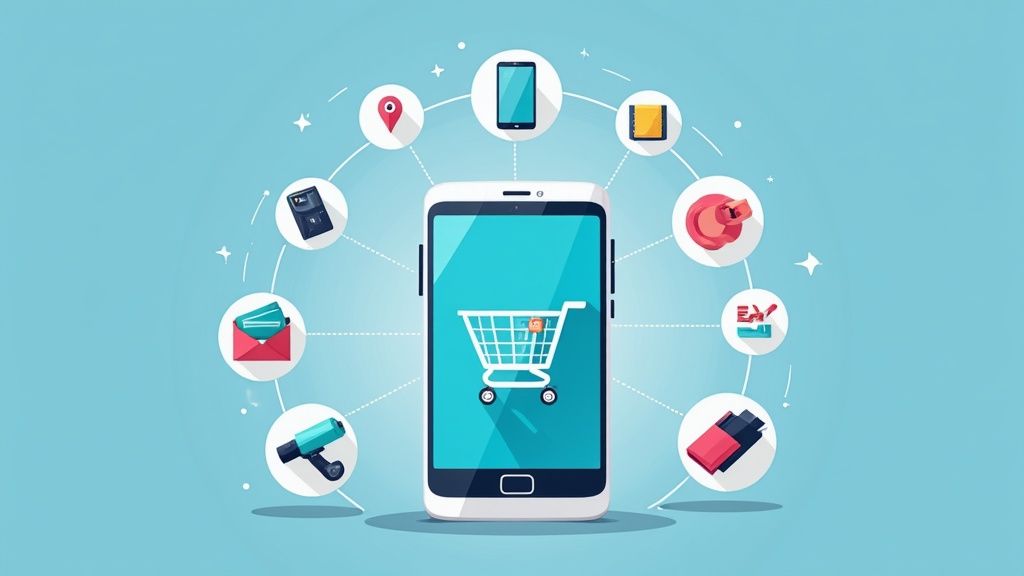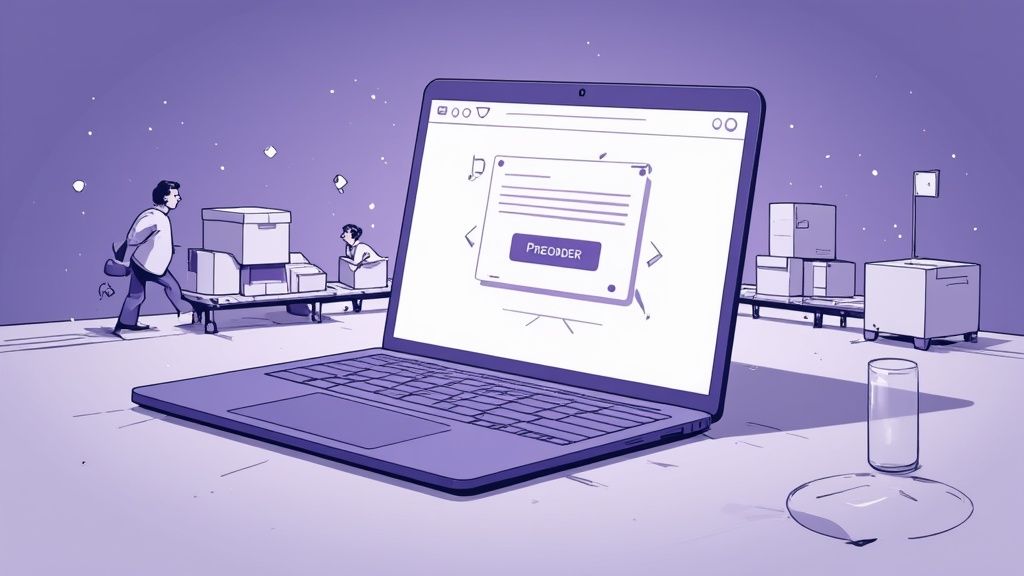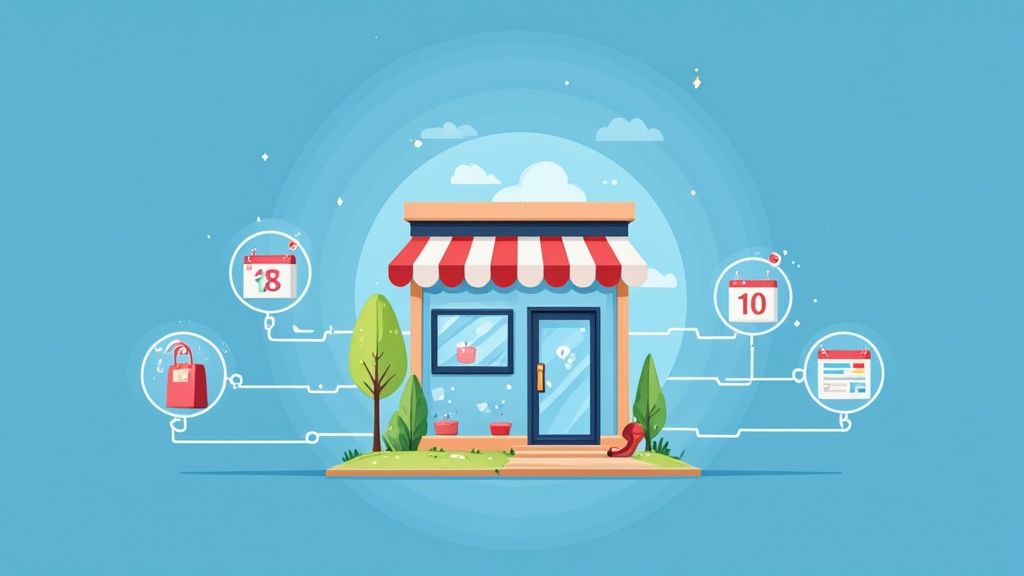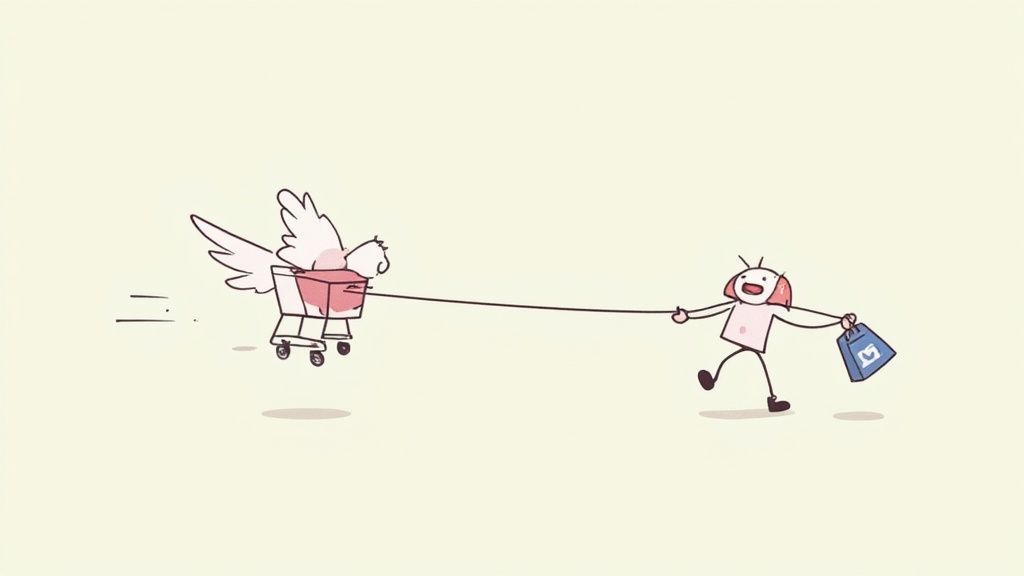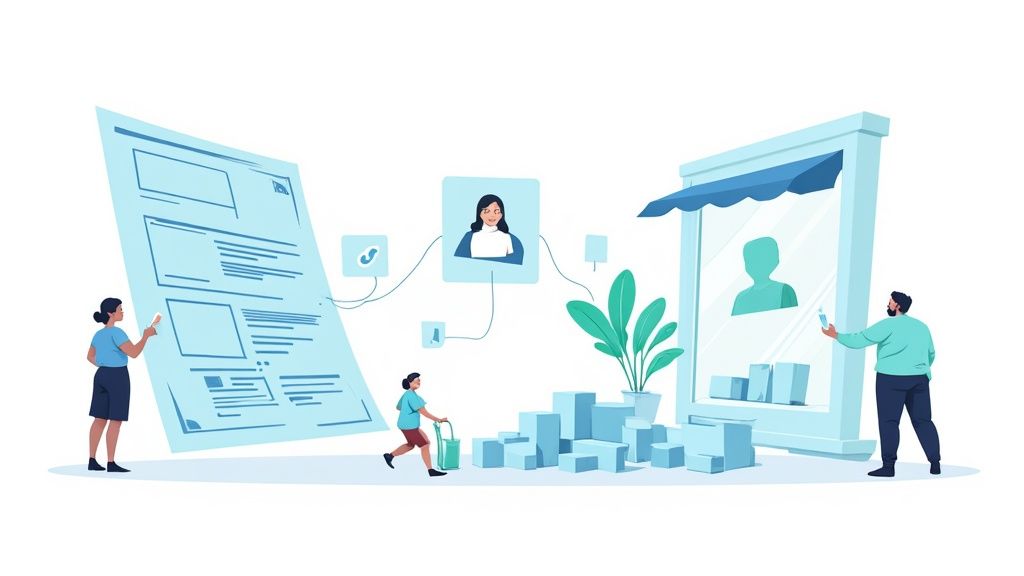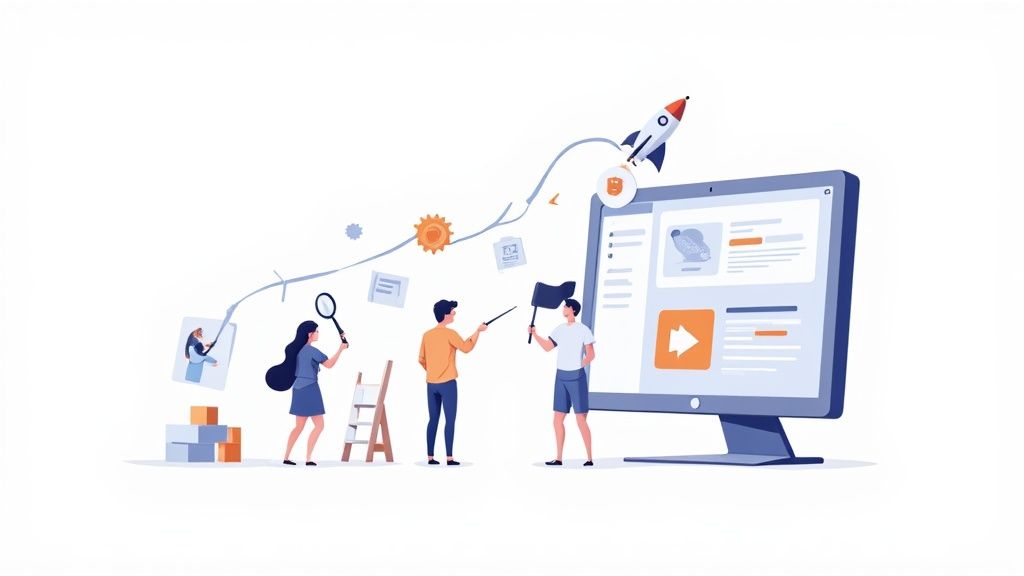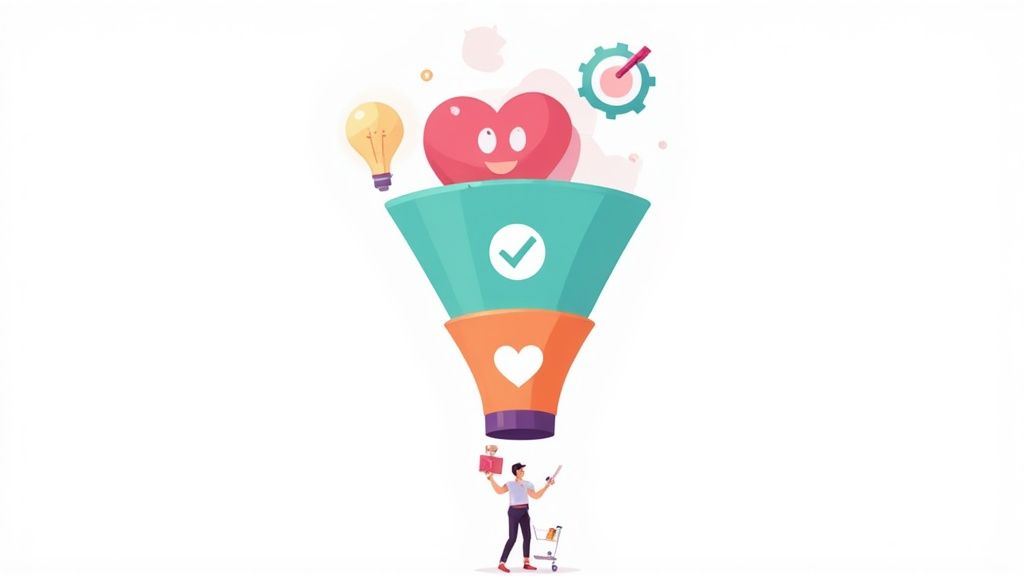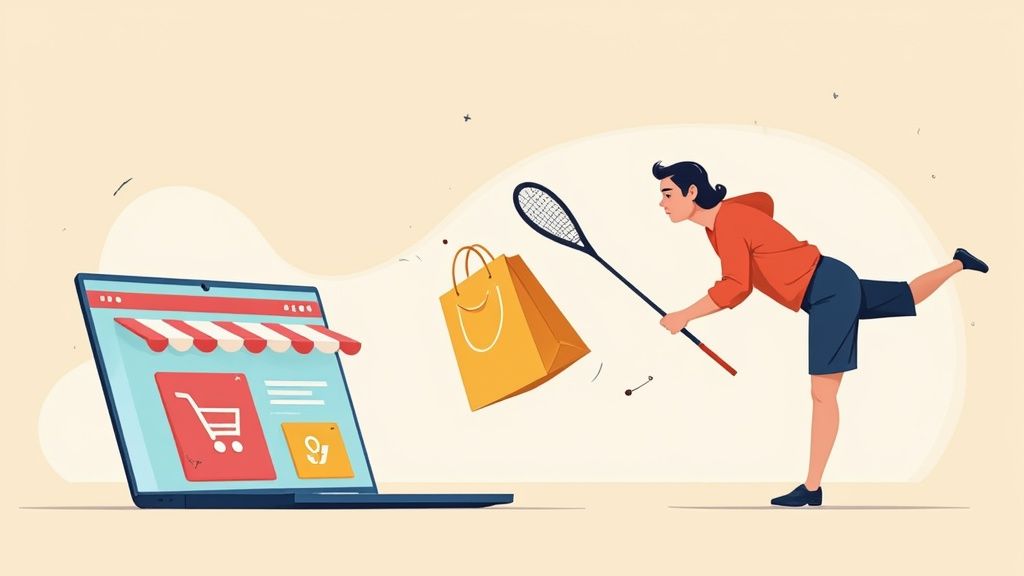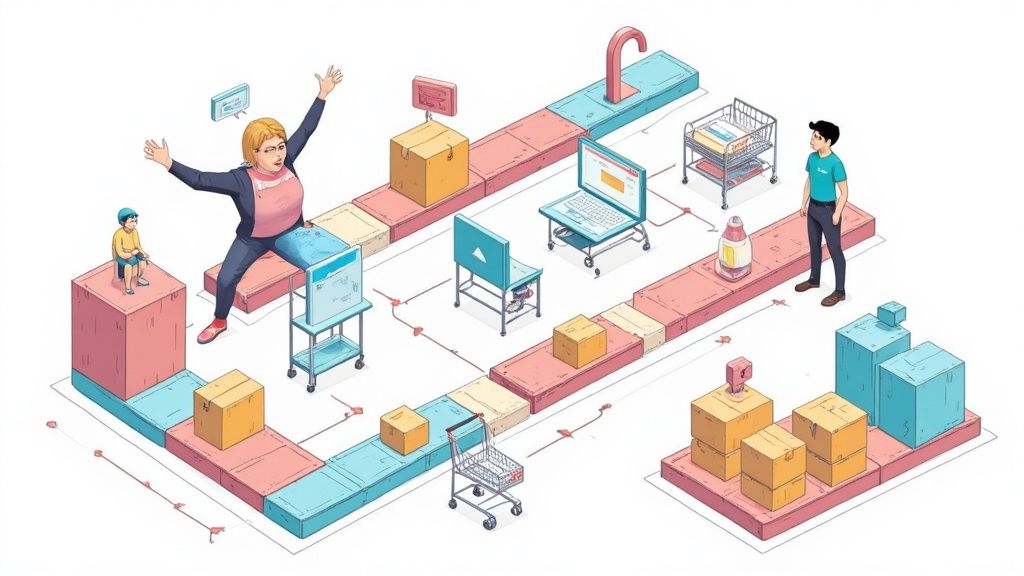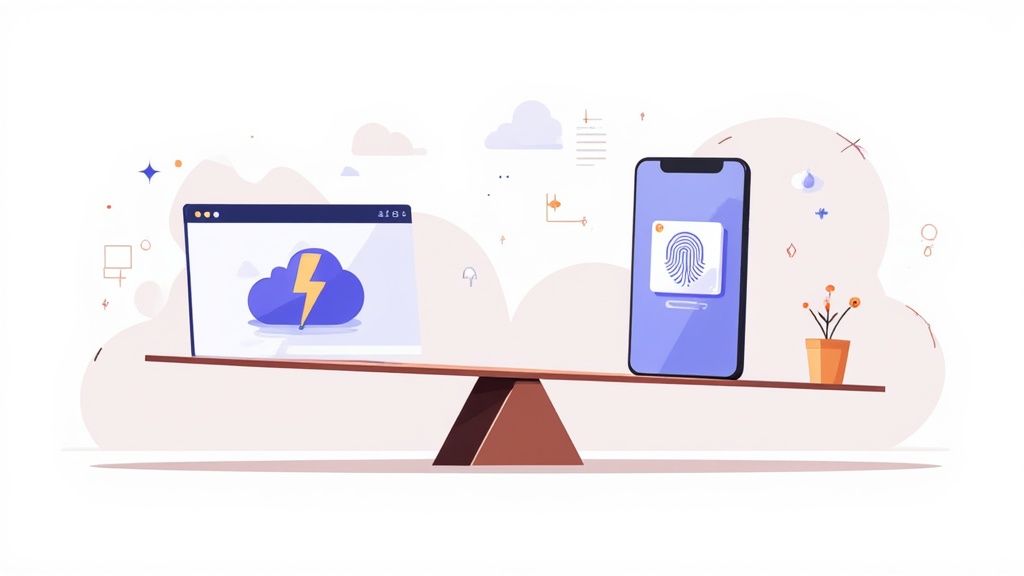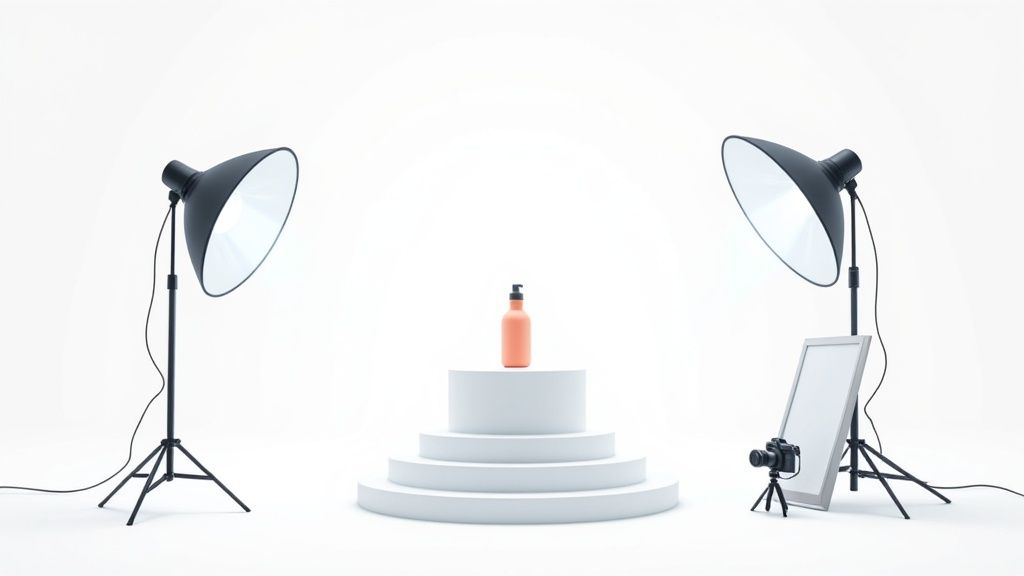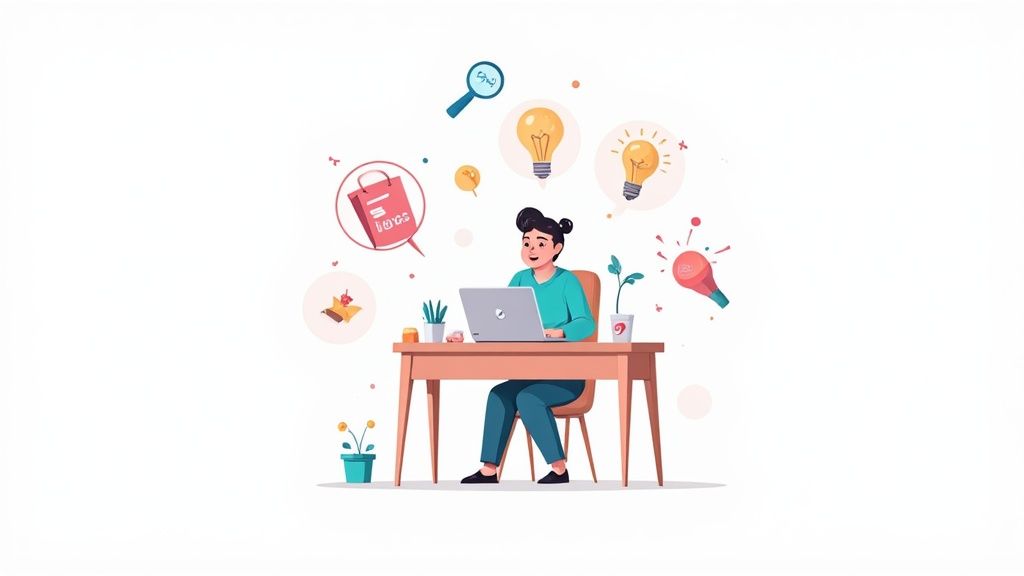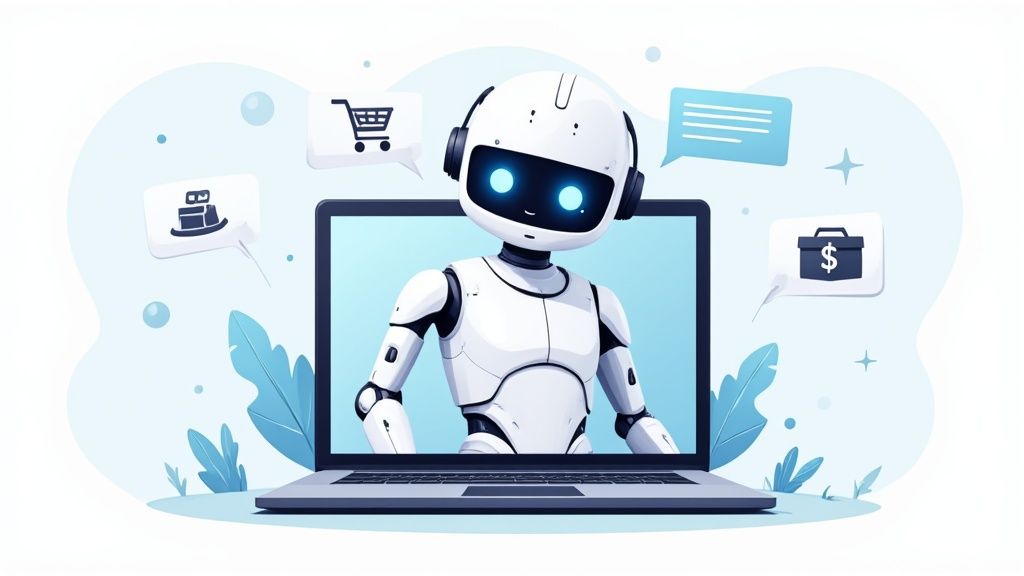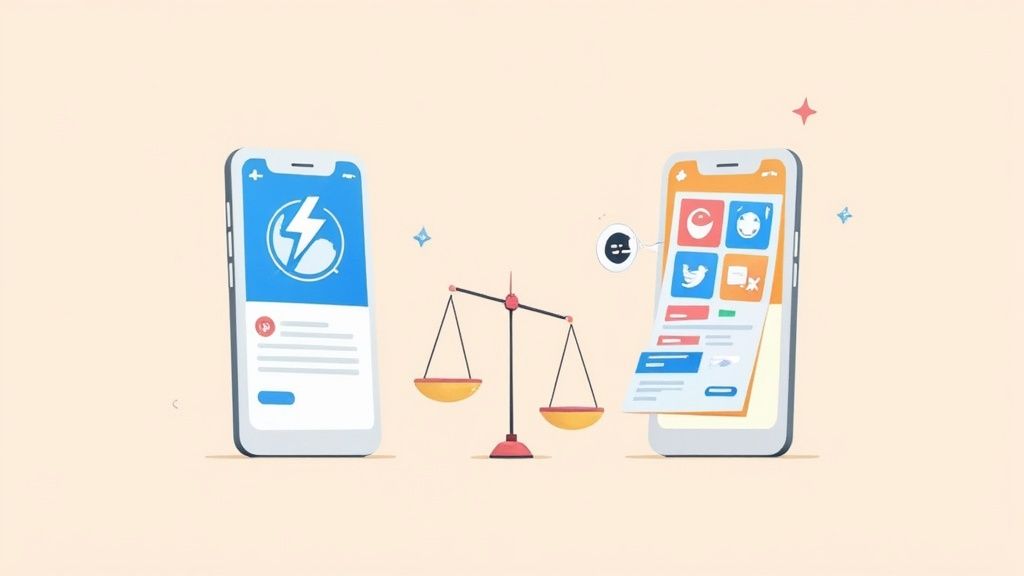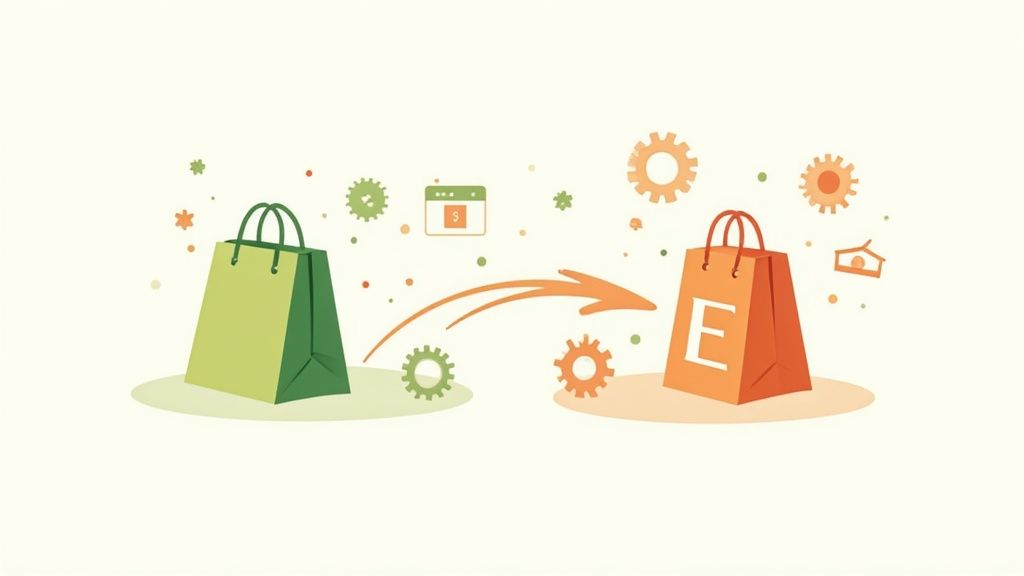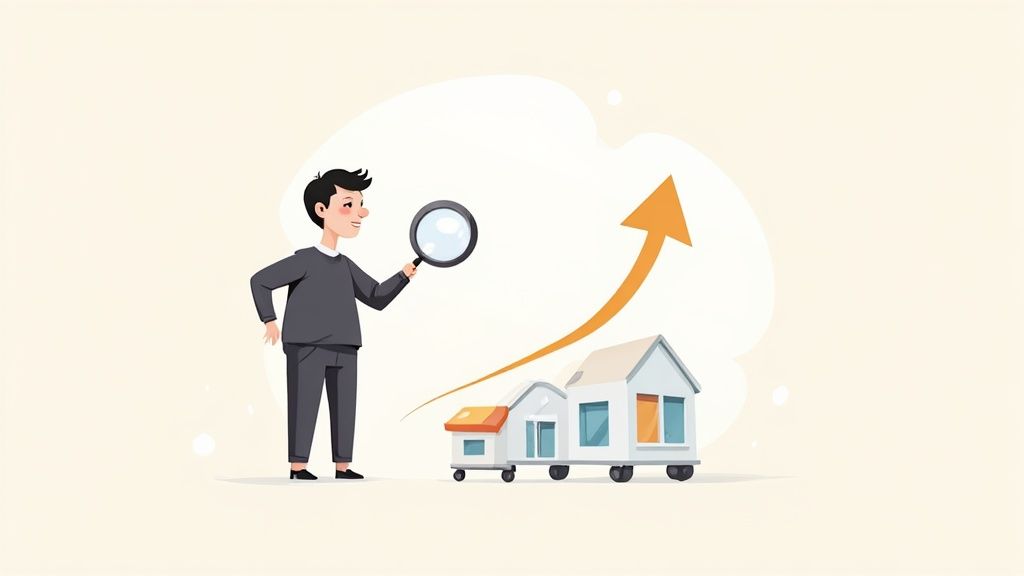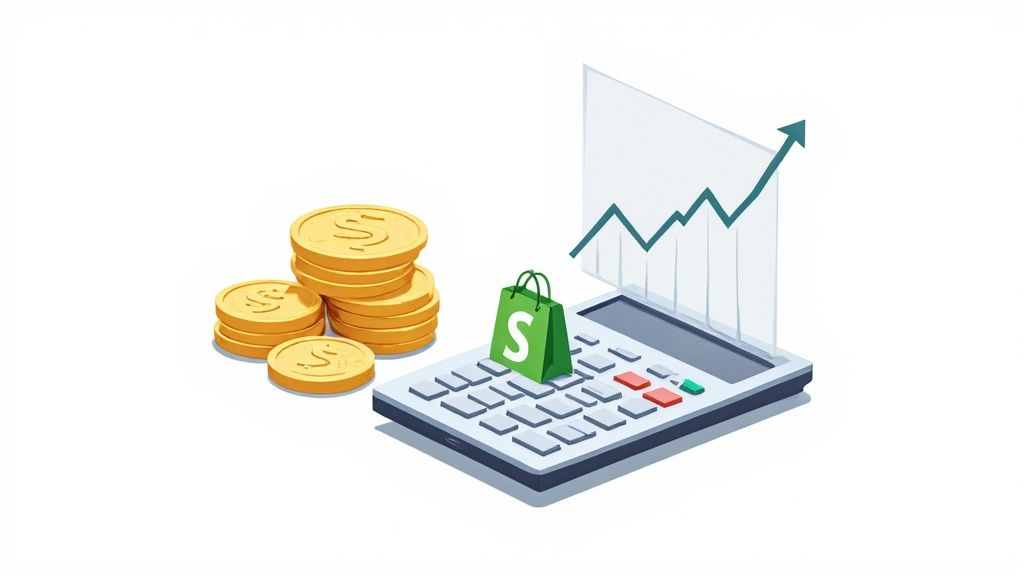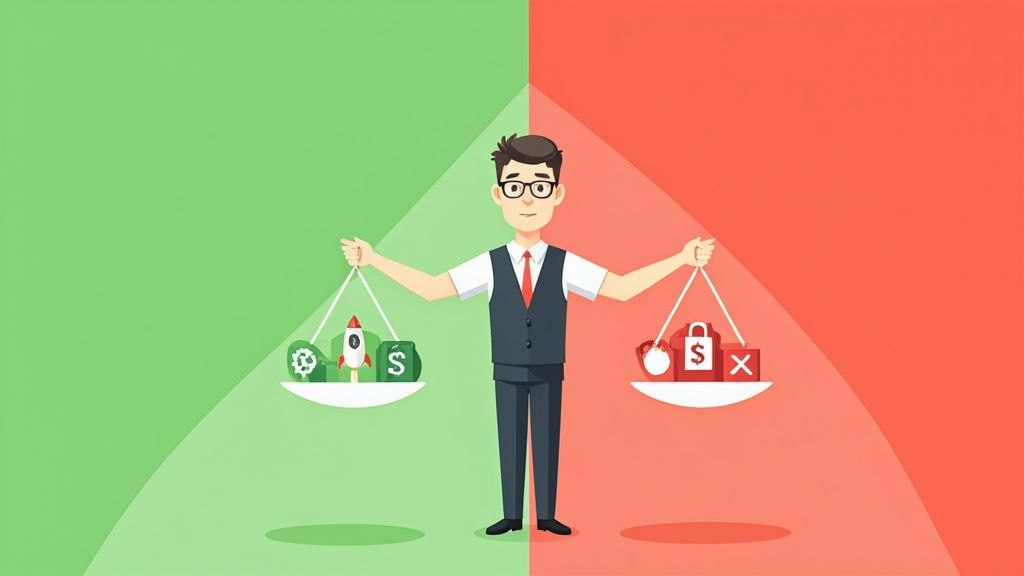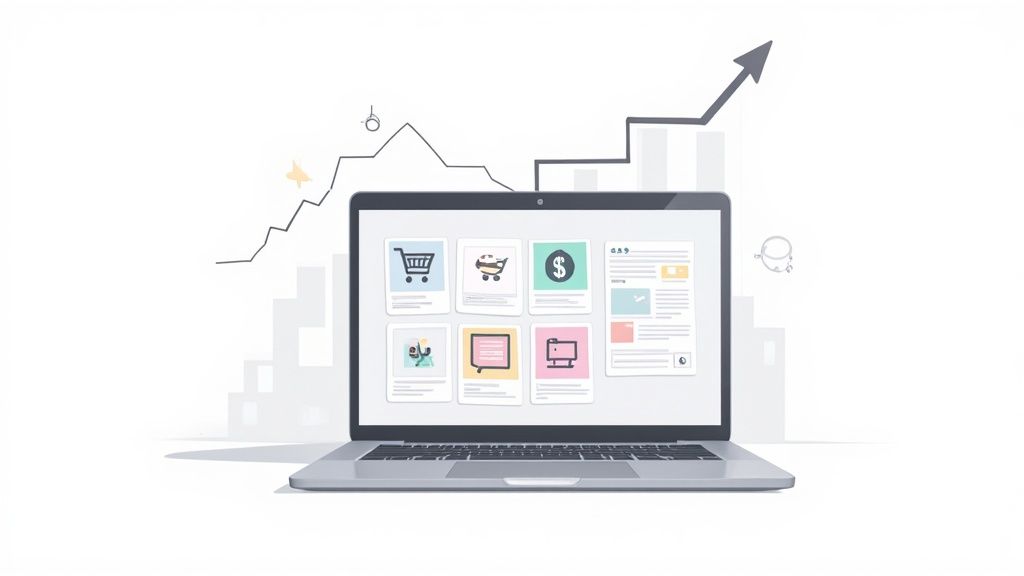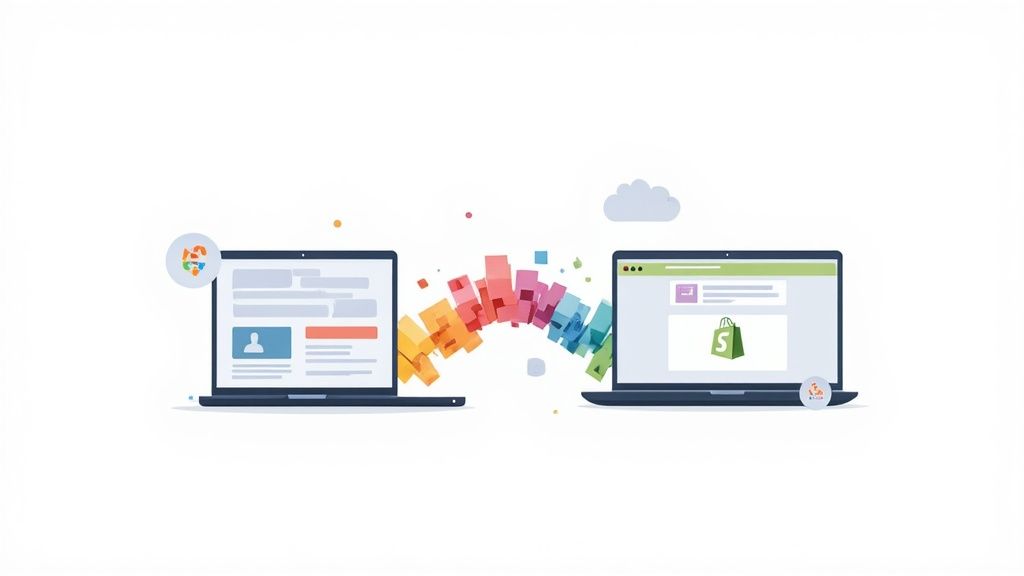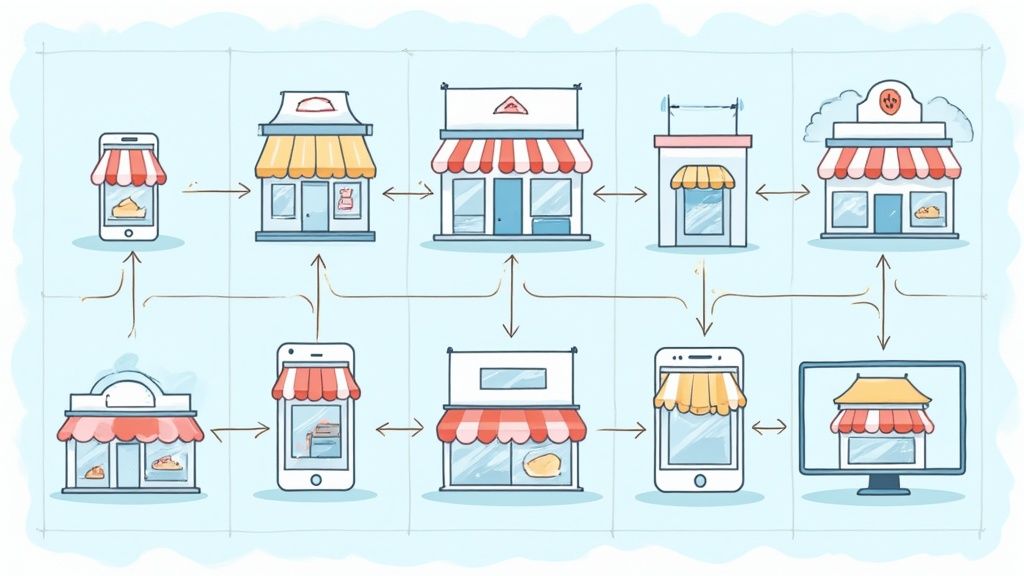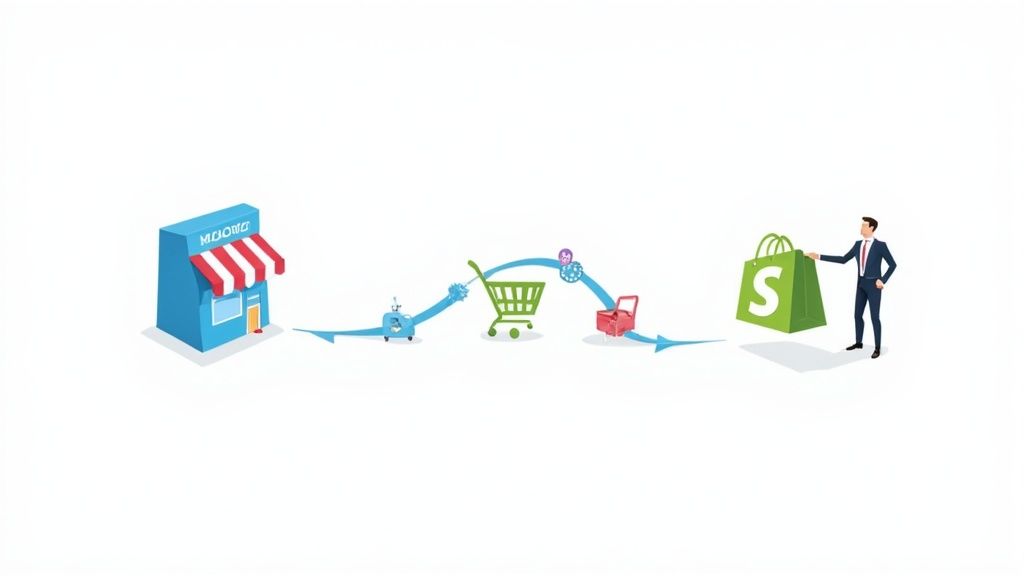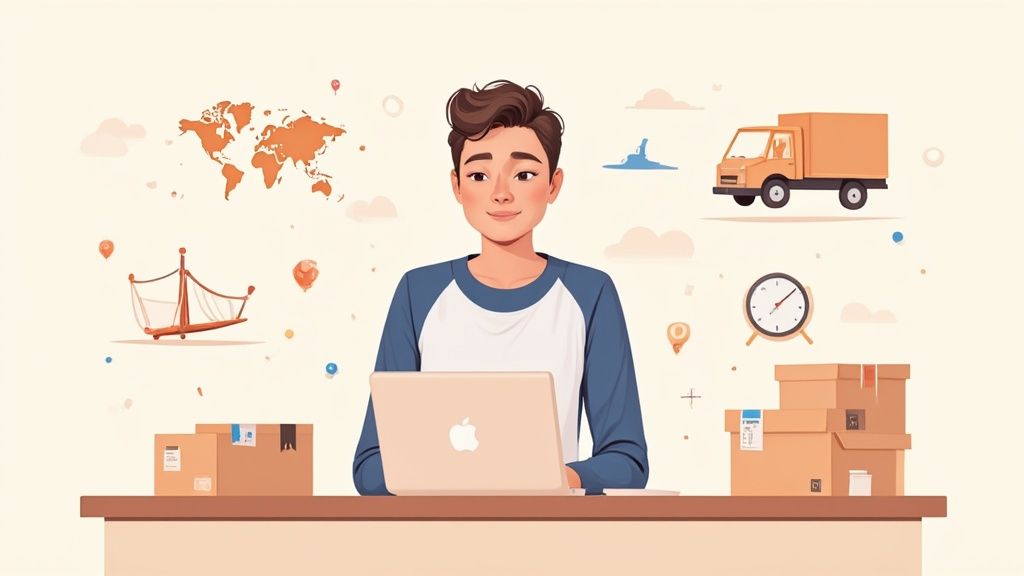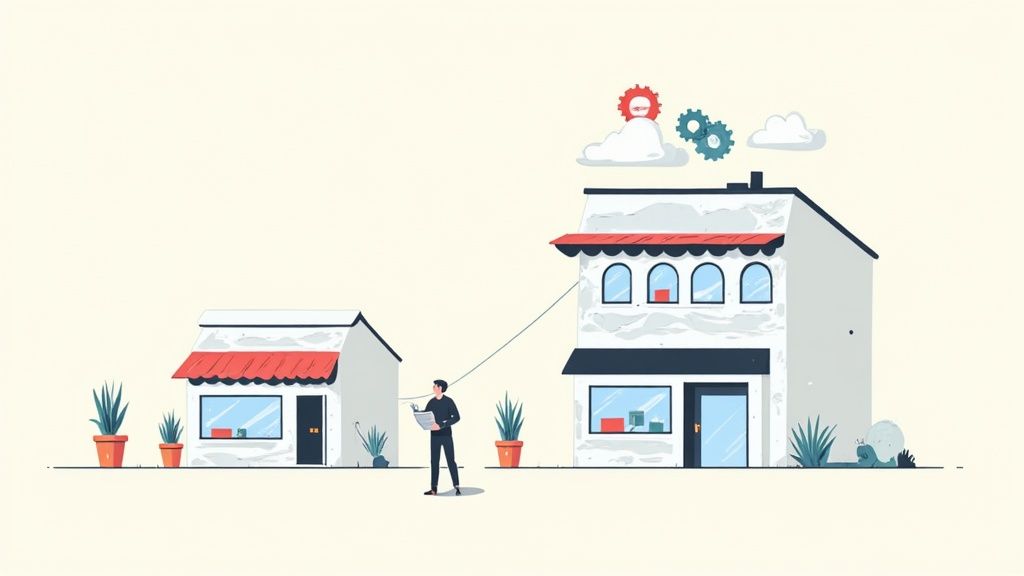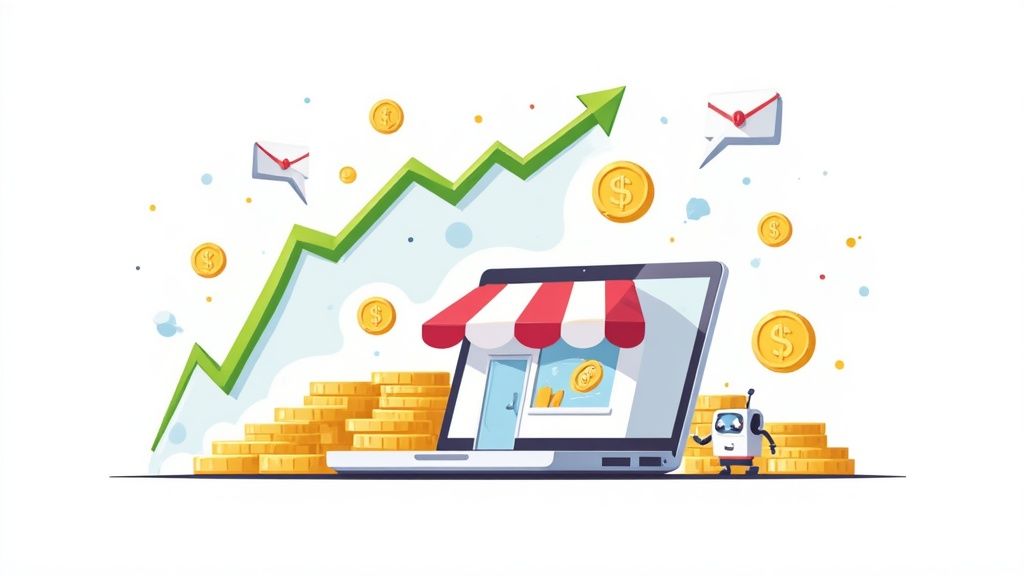
Before you even think about scaling your Shopify business, you need a rock-solid foundation. Driving traffic to a store that isn't optimized is like pouring water into a leaky bucket—it's expensive, frustrating, and ultimately, a waste of your marketing budget.
The goal is to make the path from discovery to checkout so smooth that customers don't even have to think about it. Let's dig into how to turn your store into a conversion machine.
Optimize Your Store For Effortless Conversions

This whole process starts with your product pages. Think of them as your digital salespeople; they need to do a lot more than just list features. Mastering the art of writing engaging product descriptions that sell for Shopify is non-negotiable.
Don't just list specs—tell a story. How does your product solve a real-world problem or make your customer's life better? Focus on the benefits and use sensory words that paint a picture.
Crafting a High-Trust Shopping Experience
Trust is the currency of ecommerce. No trust, no sales. It’s that simple. Your first and best chance to build that trust is with high-quality visuals. Grainy, poorly lit photos scream "unreliable business," scaring off potential buyers before they even read your description.
Invest in professional photography or learn how to take bright, crisp photos that show your product from every conceivable angle. Lifestyle shots are golden—they help customers visualize the product in their own lives. Better yet, use video. A quick demo can answer questions and squash objections in seconds.
Beyond visuals, you need to sprinkle trust signals throughout your store. These are the little reassurances that tell a shopper your business is legit and their purchase is safe.
Here are the must-haves:
- Authentic Customer Reviews: Nothing sells like social proof. People trust other shoppers way more than they trust you. Get those reviews front and center.
- Clear Policies: Your shipping, return, and privacy policies need to be dead simple to find and understand. Any confusion here is a one-way ticket to an abandoned cart.
- Secure Payment Badges: Slap those Visa, Mastercard, and PayPal logos near your checkout buttons. It’s a small detail that instantly reassures customers their financial info is secure.
Your store's design isn't just about looking pretty; it's about psychology. Every single element—from the color of your 'Add to Cart' button to the placement of a security badge—either builds confidence or creates friction. Your job is to eliminate every possible reason for a customer to hesitate.
Eliminating Friction From Your Sales Funnel
Friction is any obstacle that makes the buying process a pain. Finding and crushing these friction points is the core of conversion rate optimization. The ecommerce world is cutthroat. As of June 2025, there are a staggering 5.8 million live Shopify stores globally. With over 520,000 stores in the apparel category alone, customers have endless options and zero patience for a clunky website. You can see more competitive stats on Sumtracker.
Start with your navigation. Can visitors find what they're looking for in a few clicks? A confusing menu is a dead end. Your site structure should be logical and intuitive, guiding users exactly where you want them to go.
The checkout process is another friction hotspot. A long, complicated checkout is a guaranteed way to lose sales.
Simplify it by:
- Offering a guest checkout option.
- Keeping form fields to an absolute minimum.
- Providing multiple payment methods like Shop Pay, PayPal, and Google Pay.
To help you get started, here's a quick checklist of the foundational elements every Shopify store needs to nail for better conversions.
High-Impact Conversion Elements for Your Shopify Store
Nailing these basics is just the beginning, but it's the most important step. Once you've got this foundation in place, every dollar you spend on marketing will work harder for you.
For a deeper dive, check out our https://www.ecorn.agency/blog/double-shopify-conversion-rate-data-driven-guide for more advanced strategies you can implement right away.
Attract Qualified Buyers with SEO and Content
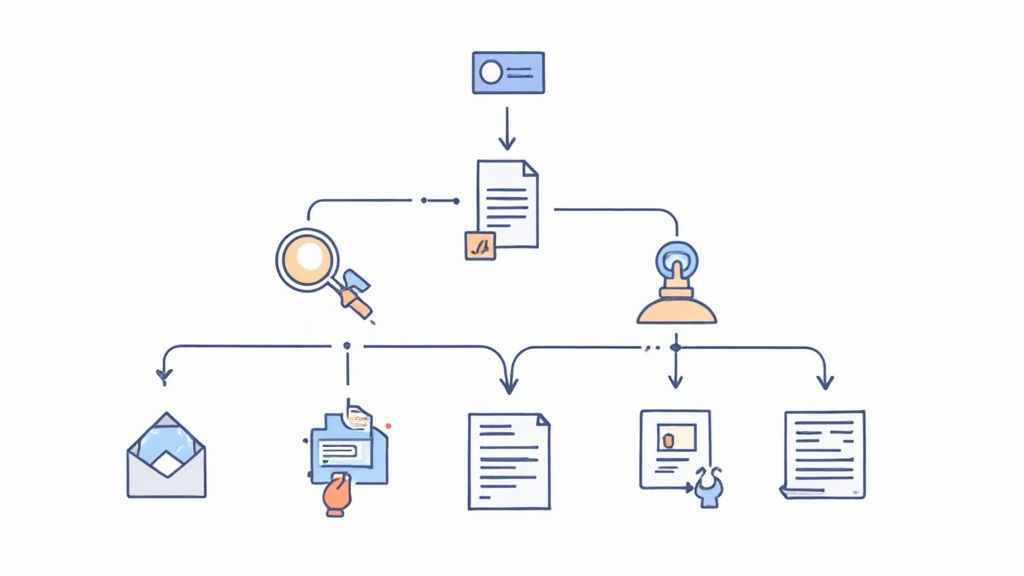
Paid ads can give you a quick jolt of sales, sure. But for real, sustainable growth, you need to attract customers who are already out there looking for what you sell. This is where search engine optimization (SEO) and content marketing shift from being buzzwords to your most valuable assets for increasing Shopify sales.
Forget the old days of stuffing keywords into every spare inch of your site. Modern SEO is all about creating genuinely helpful, valuable content that solves problems for your ideal customer. When you get this right, Google rewards you with a steady stream of free, high-intent traffic, month after month.
This isn't just a "nice-to-have" strategy anymore; it's essential. E-commerce is projected to make up 21.1% of all global retail sales by 2026, and that number is only going up. With more people shopping online than ever, a solid organic strategy is what separates the winners from the noise. You can read more about these global e-commerce trends on Shopify's blog.
Build Your Content Foundation with a Blog
Your Shopify blog is the engine of your entire content strategy. It's your home base for establishing expertise, building trust, and answering the very questions your future customers are typing into search engines. Think of every single blog post as a new digital doorway to your store.
The key is to stop writing about your products and start writing about the problems your products solve.
- Selling high-performance running shoes? Your blog should have articles like, "5 Common Running Injuries and How to Prevent Them" or "A Beginner's Guide to Choosing the Right Running Shoe."
- Selling organic skincare? You should be creating content like, "How to Build a Skincare Routine for Sensitive Skin" or "The Top 5 Natural Ingredients Your Skin Loves."
This approach flips the script. You become a helpful resource, not just another store. Once a reader trusts your advice, they're far more likely to trust—and buy—the product recommendations you naturally weave into that content.
Optimizing Your Site Structure and Pages
Great SEO isn't just about your blog. The very architecture of your Shopify store plays a huge part in how easily search engines can understand and rank your pages. A clean, logical site structure isn't just user-friendly; it's SEO-friendly.
Your collection pages, for instance, are absolute goldmines for targeting broader, high-value keywords. If you sell hiking gear, you need a collection page laser-focused on terms like "waterproof hiking boots" or "lightweight camping tents." This means writing unique, descriptive content for each collection page, not just slapping a grid of products on a blank template.
Now for the secret weapon: internal linking. This is just the simple act of linking from one page on your site to another relevant one. When you publish that blog post on "What to Pack for a Weekend Hiking Trip," you should be linking out to your collections for backpacks, hiking boots, and waterproof jackets.
This one simple practice does two critical things: it guides users deeper into your store to discover more products, and it sends powerful signals to Google about which pages are most important, passing "link equity" between them and boosting their potential to rank.
Earning Authority with Quality Backlinks
Finally, there's off-page SEO, which is all about building your store’s reputation across the web. The single most powerful way to do this is by earning backlinks—links from other websites that point to yours. Think of every high-quality backlink as a vote of confidence, telling search engines your store is a credible, authoritative source worth showing to their users.
But let me be clear: quality blows quantity out of the water. One link from a highly-respected industry blog is worth a hundred links from spammy, irrelevant sites.
So how do you actually get them?
- Guest Posting: Write a genuinely useful article for another blog in your niche and include a natural link back to your store.
- Collaborations: Team up with influencers or complementary brands on a project, guide, or giveaway that leads to organic mentions and links.
- Create "Linkable Assets": Develop something so uniquely valuable that people can't help but link to it. This could be an in-depth guide, an original data study, or a free tool that solves a common problem.
Building a solid SEO and content foundation is a marathon, not a sprint. But the investment pays off with a consistent flow of qualified traffic that's actively looking for products just like yours—delivering one of the most cost-effective ways to grow your Shopify sales for years to come.
Drive Repeat Purchases with Email and SMS
Let’s be honest: acquiring a brand new customer is expensive. Really expensive. In fact, it can cost five times more than just keeping an existing one happy. This simple truth is why your biggest growth opportunities aren't always about finding new buyers—they're about turning the customers you already have into loyal fans who come back again and again.
When it comes to building that loyalty, email and SMS marketing are your heavy hitters. Forget trying to game social media algorithms you can’t control. Your subscriber lists are direct lines of communication to people who already know and like what you do.
Let's get the essential automated funnels built that will start working for you around the clock.
Set Up Your Essential Automated Flows
Automation is your best friend in ecommerce. It's what allows you to send the perfect message at the perfect time, creating a personalized experience for every customer without you having to lift a finger. Think of these flows as your tireless digital sales team, always on and ready to engage.
There are three automated flows that are completely non-negotiable for any Shopify store:
- The Welcome Series: This is your chance to make a killer first impression. A single "welcome" email just doesn't cut it anymore. You need a series of 3-5 emails that tell your brand story, show off your best-selling products, and maybe include a small welcome offer to nudge them toward that all-important first purchase.
- The Abandoned Cart Sequence: Did you know that nearly 70% of online shopping carts are left behind? It's a staggering number, but you can get a lot of them back. An automated email or SMS, sent just a few hours after a customer leaves, can recover a huge chunk of that lost revenue. Just remind them what they were looking at, maybe address common objections like shipping costs, and create a little friendly urgency.
- The Post-Purchase Follow-Up: The customer's journey isn't over when they click "buy." A solid post-purchase flow is crucial. It should thank them for their order, give them shipping updates, and—this is the golden ticket—ask for a review a week or two later. Positive reviews are social proof gold, and this is the absolute best time to ask.
Don't just sell; build a relationship. Your email and SMS channels are for conversations. Use them to provide value, share your brand's personality, and make your customers feel seen. That's how you turn a one-time transaction into long-term loyalty.
Personalize Your Messaging with Segmentation
Sending the same generic message to your entire list is a surefire way to get ignored (or worse, get that unsubscribe click). The real magic happens when you start segmenting your audience based on what they actually do. This lets you send highly relevant offers that feel like they were written just for them.
For a deeper look into these strategies, our guide on email marketing in ecommerce goes into much more detail.
To get started, here are a few simple but powerful segments every store should have:
- New Subscribers: These people are interested but haven't pulled the trigger yet. Your welcome series is built specifically for this group.
- First-Time Customers: A month after their first purchase, send them a targeted follow-up. You could suggest products that complement what they bought or simply offer a "thank you" discount for their next order.
- VIP Customers: These are your rockstars—the people who buy often or spend a lot. Treat them like it! Give them early access to new products, exclusive discounts, or enroll them in a loyalty program.
- Lapsed Customers: Someone hasn't bought in 90 days? It's time for a gentle nudge. A "we miss you" campaign with a compelling offer is a great way to win them back.
By tailoring your communication, you’re showing customers that you get them and you value their business. This kind of personalized approach is the foundation of a lasting relationship. To explore this further, check out these excellent tips on maximizing customer retention with a small business loyalty program.
At the end of the day, email and SMS aren't just about blasting out promotions. They’re about building a genuine community around your brand, nurturing those customer relationships, and creating a reliable revenue stream that will drive sustainable growth for your Shopify store.
Scale Your Reach with Paid Ads and Social Commerce
Organic growth is the long game. It's fantastic for building a sustainable brand, but let's be honest—it can be slow. When you need to light a fire under your sales right now, paid advertising and social commerce are your most direct routes to growth. This is how you get your products in front of the right people, at the right time.
But diving in without a solid plan is like throwing money into a bonfire. Success isn't about outspending your competitors; it’s about outsmarting them. And that all starts with knowing exactly who you're talking to.
Defining Your Ideal Customer for Paid Campaigns
Before you even think about campaign settings or ad creative, you need a crystal-clear picture of your ideal customer. And I don't just mean basic demographics. What podcasts do they listen to? Which influencers do they follow on TikTok? What keeps them up at night that your product can solve?
Let’s say you sell high-end, ergonomic office chairs. You’re not just targeting "remote workers." You're targeting distinct personas:
- The Tech Professional: They're 30-45, follow productivity gurus, and see a $1,000 chair as an investment in their career. They'll respond to ads on LinkedIn and tech news sites that focus on performance and specs.
- The Freelance Creative: They care just as much about aesthetics as they do about comfort. You'll find them scrolling through Instagram and Pinterest, saving beautifully designed workspaces. Your ads here should be visual, maybe showing the chair in a stunning home office.
- The Small Business Owner: They're practical and budget-conscious, looking for a durable solution to prevent back pain. They are most likely searching on Google for "best office chair under $500."
See the difference? Each group needs a unique message, a different visual, and will be found on a different platform. Nailing this down is what separates a wildly profitable campaign from a costly mistake.
Choosing the Right Ad Platform for Your Shopify Store
Where you spend your money matters just as much as who you're targeting. Different platforms cater to different behaviors and intentions. Here’s a quick breakdown to help you decide where to start.
Start by focusing on one or two platforms where your ideal customer spends the most time. It’s far better to master one channel than to spread your budget too thin across all of them. Once you have a winning formula, you can expand.
Navigating the Advertising Funnel
Blasting a "Buy Now!" ad at someone who's never heard of you is a recipe for wasted ad spend. You have to warm them up first. Think of it as a journey—the advertising funnel.
- Top of Funnel (Awareness): This is your first impression. The goal is simple: introduce your brand. Use eye-catching video ads or lifestyle imagery that stops the scroll and makes people curious.
- Middle of Funnel (Consideration): These folks have shown interest. Maybe they visited your site or engaged with a post. It's time to retarget them. Show them ads that highlight key product benefits, feature glowing customer testimonials, or offer a useful download.
- Bottom of Funnel (Conversion): This is where you close the sale. These are your hottest leads—they’ve added items to their cart or viewed a product multiple times. Hit them with a clear call to action. A little nudge, like a reminder about free shipping, can work wonders here.
The real magic of paid ads is in the retargeting. Someone who has already visited your store is infinitely more likely to buy than a total stranger. Pour a significant chunk of your budget into bringing these high-intent visitors back to finish what they started.
This simple decision tree shows how you can think about nurturing different types of customers to keep them coming back.

Whether you're welcoming new buyers or trying to win back old ones, tailoring your approach is key.
Tapping into the Power of Social Commerce
Social commerce is all about closing the gap between discovery and purchase. Instead of making someone leave their feed, click a link, open a new tab, and navigate your site, you let them buy right there in the app. It's genius.
Platforms like Instagram and Facebook Shops let you tag products directly in your content. A shopper sees a jacket they love, taps the tag, and can check out in a few clicks without ever leaving the app. This slashes friction and is incredibly effective for capturing those impulse buys.
This frictionless shopping is fueling a massive industry. For Q1 2025, Shopify announced a staggering revenue of $2.36 billion, a 26.81% jump from the previous year. Their Gross Merchandise Volume hit a record $292.3 billion in 2024. These numbers show just how much commerce is happening on platforms that integrate perfectly with social channels. You can read more about Shopify's massive merchant revenue growth to see the scale.
Combine highly targeted ads with the seamless checkout of social commerce, and you've got yourself a powerful engine for immediate, scalable growth. You meet customers exactly where they are and make it incredibly easy for them to say "yes."
Use Smart Apps and AI to Boost Sales
Trying to manually manage every single part of your Shopify store—from customer service tickets to marketing campaigns—is a one-way ticket to burnout. The real secret to scaling your business isn't about working harder; it's about working smarter. This is where the Shopify App Store truly shines, offering a goldmine of powerful automations and AI-driven tools.
By plugging in the right apps, you can put repetitive tasks on autopilot, create deeply personalized shopping experiences, and start making data-backed decisions that directly increase Shopify sales. Think of these apps as a team of specialized employees working for you 24/7, constantly optimizing your store for more revenue with less hands-on effort.
Automate and Personalize the Customer Journey
One of the fastest wins you can get with AI is through smarter product recommendations. The old-school "customers also bought" widgets just don't cut it anymore. Today's AI apps dig into a user's real-time browsing, their purchase history, and even what similar shoppers have bought to serve up hyper-relevant suggestions.
Imagine a customer is checking out a high-end espresso machine. A smart AI app can instantly show them the perfect grinder, a specific brand of coffee beans that pairs well with it, and even a subscription for those beans—all without them leaving the page. This doesn't just bump up your average order value (AOV); it makes the customer feel like you totally get them.
The goal is to make discovery effortless for the shopper. When you use AI to anticipate their next need and put the perfect product right in front of them, you're not just upselling; you're providing a genuinely helpful service that builds loyalty.
Must-Have App Categories for Growth
With thousands of apps available, it's easy to get overwhelmed. To cut through the noise, focus on app categories that solve a specific problem and have a clear, direct impact on your bottom line.
Here are the essential types of apps to look for:
- Upsell and Cross-sell Apps: These are non-negotiable for boosting AOV. Find tools that offer one-click post-purchase upsells or in-cart recommendations, as these convert at a much higher rate.
- Customer Support Chatbots: An AI chatbot can instantly handle up to 80% of common customer questions, freeing up your team for more complex issues. They can tackle everything from "Where is my order?" to shipping policy questions, making sure no customer is left waiting for an answer.
- Loyalty and Rewards Programs: These apps put customer retention on autopilot. They make it easy to set up points systems, VIP tiers, and referral bonuses that reward your best customers and keep them coming back.
- Dynamic Pricing Tools: If you have a huge catalog or operate in a super-competitive market, AI-driven pricing tools are a game-changer. They analyze competitor prices, demand, and inventory levels to automatically tweak your prices for maximum profit.
Choosing the right apps is half the battle, but you also have to make sure they don't drag your site speed down. Always check an app's reviews for comments about performance before you install it. A slow store can completely wipe out any benefits an app might bring.
Generating High-Converting Copy with AI
Let's be honest, writer's block is a real sales killer. AI copy-generation tools have moved from being a novelty to an essential part of the toolkit for creating high-quality product descriptions, email campaigns, and ad copy at scale.
For instance, you can give an AI tool a few bullet points about a new product's features, and it will spit out several compelling, benefit-focused descriptions in seconds. This lets you A/B test different angles and quickly populate your entire store with persuasive copy that turns browsers into buyers. It’s like having a creative partner who does the heavy lifting, freeing you up to focus on strategy.
Here’s a simple workflow to get you started:
- Pick a Task: Do you need new subject lines for a flash sale email? Or maybe some fresh ad copy for a Facebook campaign?
- Give It Context: Feed the AI tool the key details—who you're talking to, the product's benefits, and the tone you're going for (e.g., "playful and witty" or "professional and reassuring").
- Generate and Refine: The AI will give you several options to work with. Your job is to pick the best one and polish it with your unique brand voice to make it perfect.
When you strategically select and integrate smart apps, you build an automated ecosystem that works tirelessly to improve the customer experience and drive revenue. This approach isn't optional anymore; it's a fundamental part of any modern, successful strategy to increase Shopify sales and scale your business efficiently.
Your Shopify Sales Questions Answered
Even with the best game plan, some questions always pop up when you're trying to increase Shopify sales. I get it. You hit a wall, and you just need a straight answer to keep things moving. Let's tackle some of the most common sticking points I hear from store owners.
How Much Should I Spend on Ads?
Ah, the million-dollar question. The truth is, there's no magic number. It's all about percentages and, more importantly, performance.
A solid starting point for most brands is to earmark 10-15% of your total revenue for your marketing budget. If you've found your groove, your product is selling, and you're ready to pour some fuel on the fire, pushing that to 20% can seriously fast-track your growth.
But here's the real key: don't just "set it and forget it." You need to live and breathe your Return on Ad Spend (ROAS). If you're spending $1,000 a month and it's bringing in $5,000 in sales, that's a 5x ROAS. As long as that number is profitable for your business, you've got a green light to scale up.
What Is a Good Conversion Rate for a Shopify Store?
Numbers people love this one. On average, a Shopify store converts at about 1.4%. If you're in that ballpark, you're not failing. But let's be honest, "average" isn't the goal, is it? The stores that are really crushing it often see conversion rates of 3% or higher.
Of course, this number doesn't exist in a vacuum. A few things can really move the needle:
- Your Industry: A store selling exclusive, must-have fashion pieces will naturally convert better than one selling generic phone cases.
- Where Your Traffic Comes From: Someone who clicked a hyper-targeted Google search ad is way more likely to buy than a casual scroller from a TikTok feed.
- The Price Tag: Higher-priced items always have a longer sales cycle. People need time to think, so the conversion rate will naturally be lower.
Don't get hung up on industry benchmarks. Obsess over your data instead. If you converted at 1.5% last month and you hit 1.8% this month, that's a win. It's all about consistent, forward progress.
How Do I Compete with Bigger Brands?
You’re never going to outspend a giant like Amazon, so don't even try. Instead, you're going to out-care them. Big-box brands feel corporate and cold because they are. Your superpower is your ability to forge real connections and offer a human touch they can only dream of.
Here's how you win against the giants:
- Dominate Your Niche: Don't just sell "coffee." Sell "single-origin, ethically sourced beans for pour-over nerds." Become the undisputed expert for a very specific person.
- Deliver Blow-Your-Mind Customer Service: Answer emails and DMs like a real person, and do it fast. Tuck a handwritten thank-you note into your packages. These little things aren't scalable for the big guys, but they build unforgettable experiences for your customers.
- Tell Your Story: People don't connect with faceless corporations; they connect with other people. Share your founder's story, shout about your mission, and let customers in on what makes your products different.
When you focus on these areas, you're not just selling a product; you're building a tribe. You create a loyal following that's there for more than just a cheap price. This is how you build a brand that can weather any storm. The goal isn't to make a sale; it's to create a customer for life.
Ready to stop guessing and start growing? The team of Shopify specialists at ECORN can provide the expertise you need to optimize your store, from conversion rate optimization to full-scale development. Get a scalable solution tailored to your brand's growth stage. Let's build a more profitable store together.






